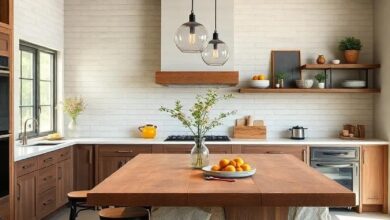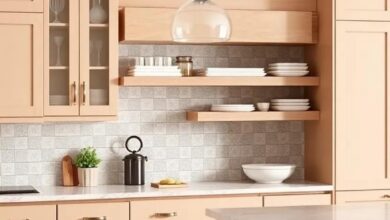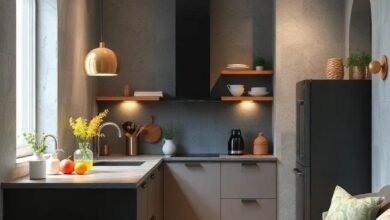Crafting Culinary Retreats: The Allure of Wood in Outdoor Kitchen Design
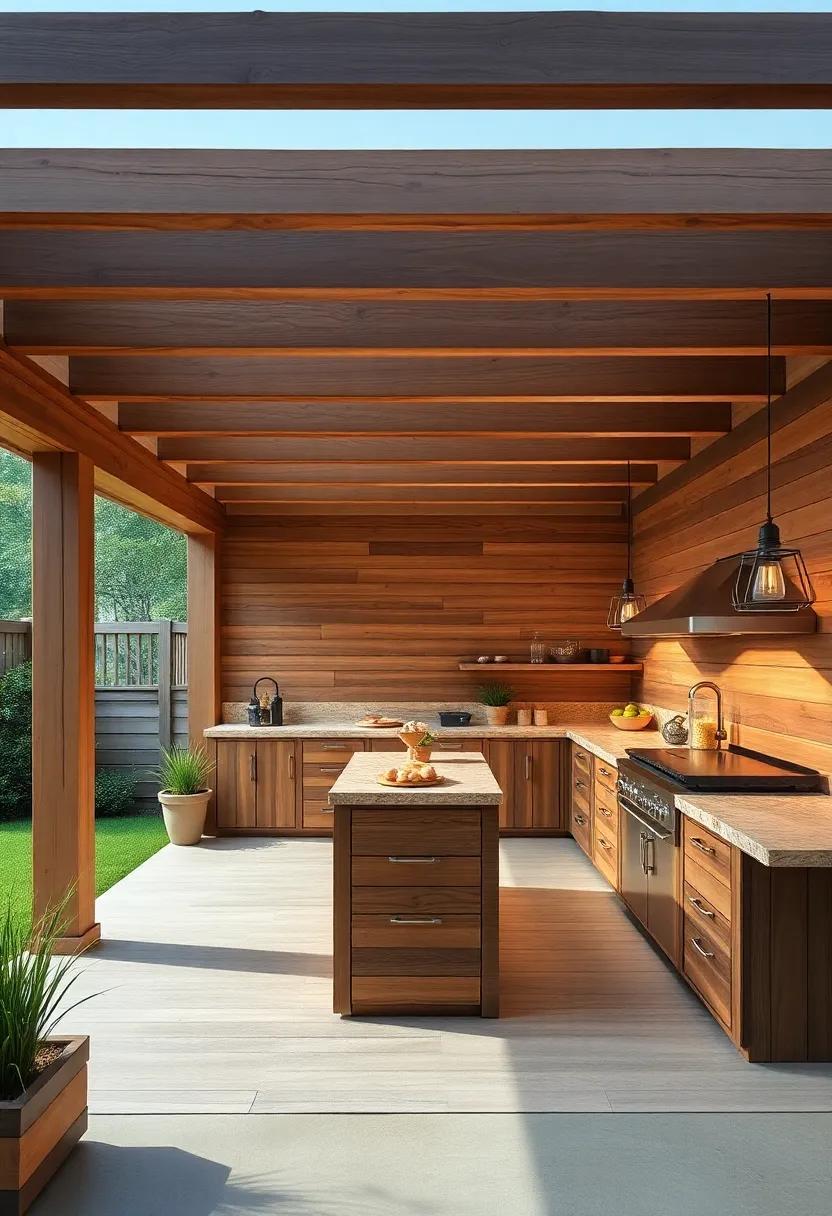
In the heart of nature, where the symphony of rustling leaves meets the sizzling sounds of gourmet cooking, the rustic charm of wood-infused outdoor kitchens beckons culinary enthusiasts to a transformative experience. Crafting culinary retreats that celebrate the art of cooking outdoors merges aesthetics with functionality, inviting individuals to reconnect with the earth and each other. The allure of wood—its warmth, texture, and organic beauty—serves as a foundational element in thes serene enclaves, harmonizing the essential elements of a kitchen with the raw splendor of the great outdoors. This article explores the multifaceted role of wood in outdoor kitchen design, unveiling how its enduring appeal not only enhances the culinary experience but also cultivates a deeper connection to nature, creativity, and the joy of shared meals. Join us as we delve into the innovative approaches and design inspirations that make outdoor kitchens an enchanting setting for both seasoned chefs and aspiring cooks alike.
Embracing the Natural Aesthetic of Wood in Outdoor Kitchen Designs
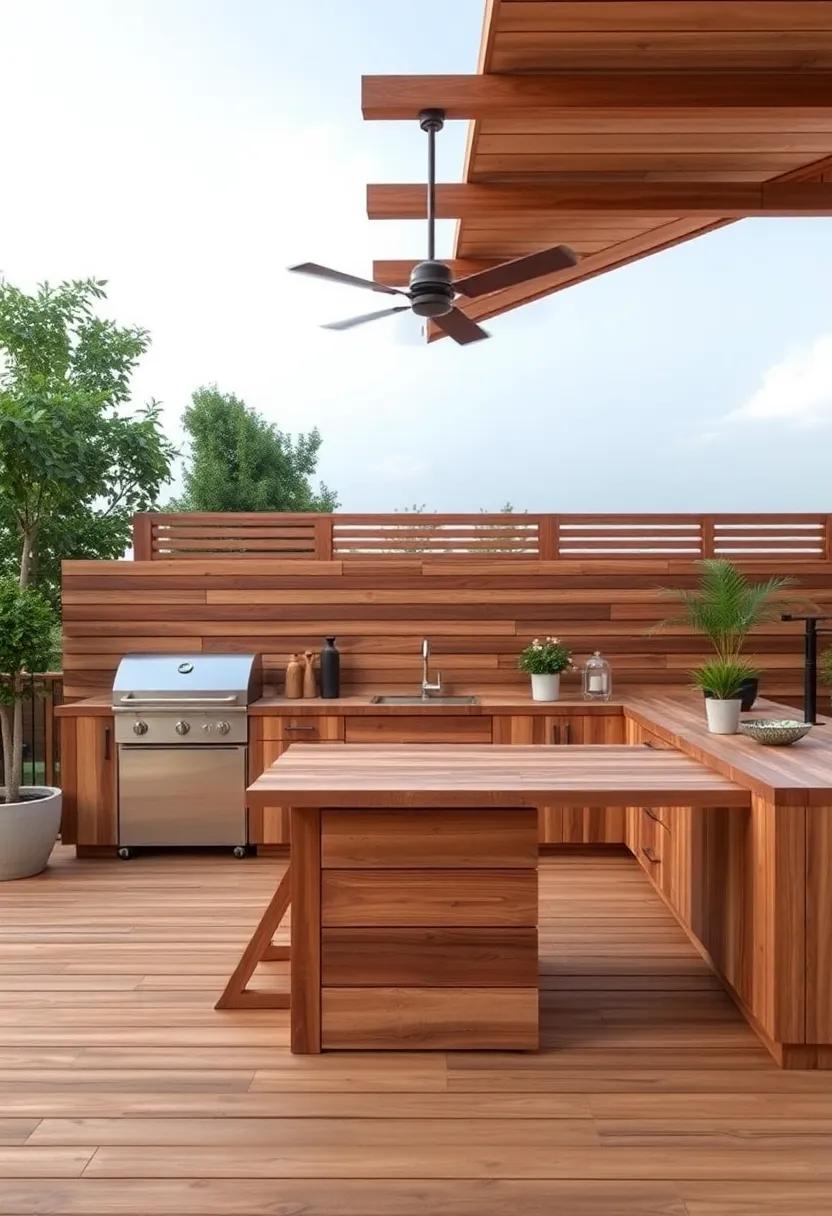
Incorporating wood into outdoor kitchen designs serves not just as a design choice but as a celebration of nature. When you think of wood, the warmth and authenticity it brings to a space are undeniable.Using natural wood elements—weather in cabinetry,countertops,or pergolas—creates a harmonious connection with the outdoor environment. Wood’s organic textures and rich tones can enhance the visual appeal of your culinary sanctuary, making it a perfect spot for gathering with family and friends. moreover, its ability to blend seamlessly with various landscaping elements promotes a cohesive aesthetic that resonates with both rustic and modern themes alike.
Practicality pairs beautifully with aesthetics in wood’s request. Consider options like weather-resistant woods such as cedar or teak, which not only offer durability but also require minimal maintenance, ensuring your outdoor kitchen remains stunning through all seasons. You can enhance this allure further with design elements such as:
- Wooden Bar Stools for comfortable seating
- Natural Wood Bar Tops for a rustic touch
- Wooden Storage Cabinets that are functional and stylish
- Vertical Wood Panels to create a striking backdrop
Additionally,embracing sustainable wood choices allows you to infuse ecological mindfulness into your design. The biophilic design principles advocate bringing the outside in, and what better way than to utilize wood to achieve this? The result is not only an aesthetically pleasing space but one that inspires culinary creativity and enjoyment amid the natural world.
Crafting Inviting Ambiance with Warm Wooden Elements in Culinary Retreats
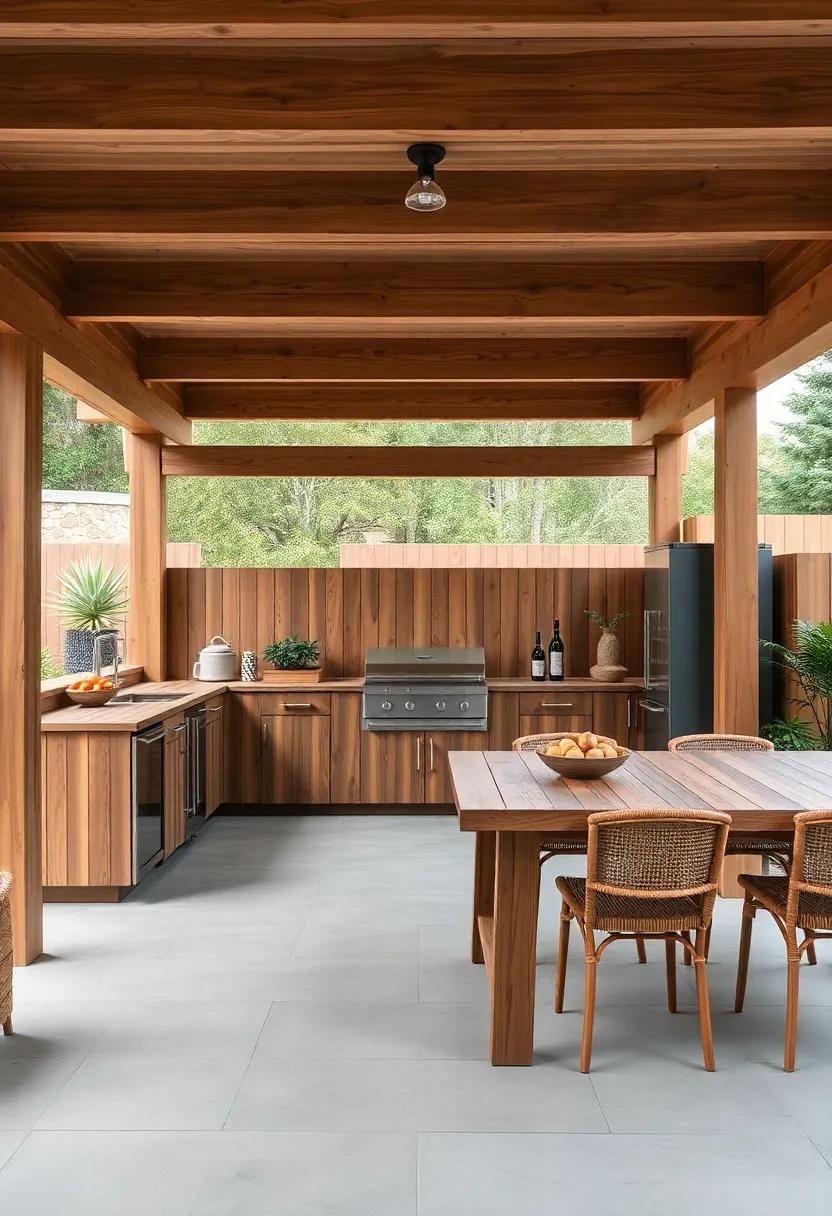
Wooden elements in outdoor kitchen design invite a sense of warmth and comfort, transforming culinary retreats into enchanting spaces. The natural grain and textures of wood bring a timeless aesthetic,harmoniously blending with the outdoor environment. Using various types of wood—like rich mahogany, rustic cedar, or weather-resistant teak—designers can create inviting surfaces that enhance the cooking experience.Key features that exemplify this ambiance include:
- Wooden countertops: Perfect for both functionality and style, this material adds a warm touch to meal planning.
- Beams and structures: Overhead wooden beams can create a cozy atmosphere while offering an architectural focal point.
- Outdoor dining sets: Handcrafted wooden tables and chairs encourage gatherings that linger into the evenings.
Moreover, incorporating wood elements into outdoor kitchens helps evoke a connection to nature, making culinary experiences more enjoyable. By choosing sustainable wood options, designers can also promote eco-friendliness while maintaining elegance. Consider implementing features such as:
| Wood Feature | Benefits |
|---|---|
| Wooden islands | Provide extra workspace and serve as social hubs. |
| Fencing and screens | Create privacy while enhancing the natural ambiance. |
| Gardening boxes | Incorporate raised garden beds for fresh herbs and vegetables. |
The Role of Reclaimed Wood in Sustainable Outdoor Culinary Spaces
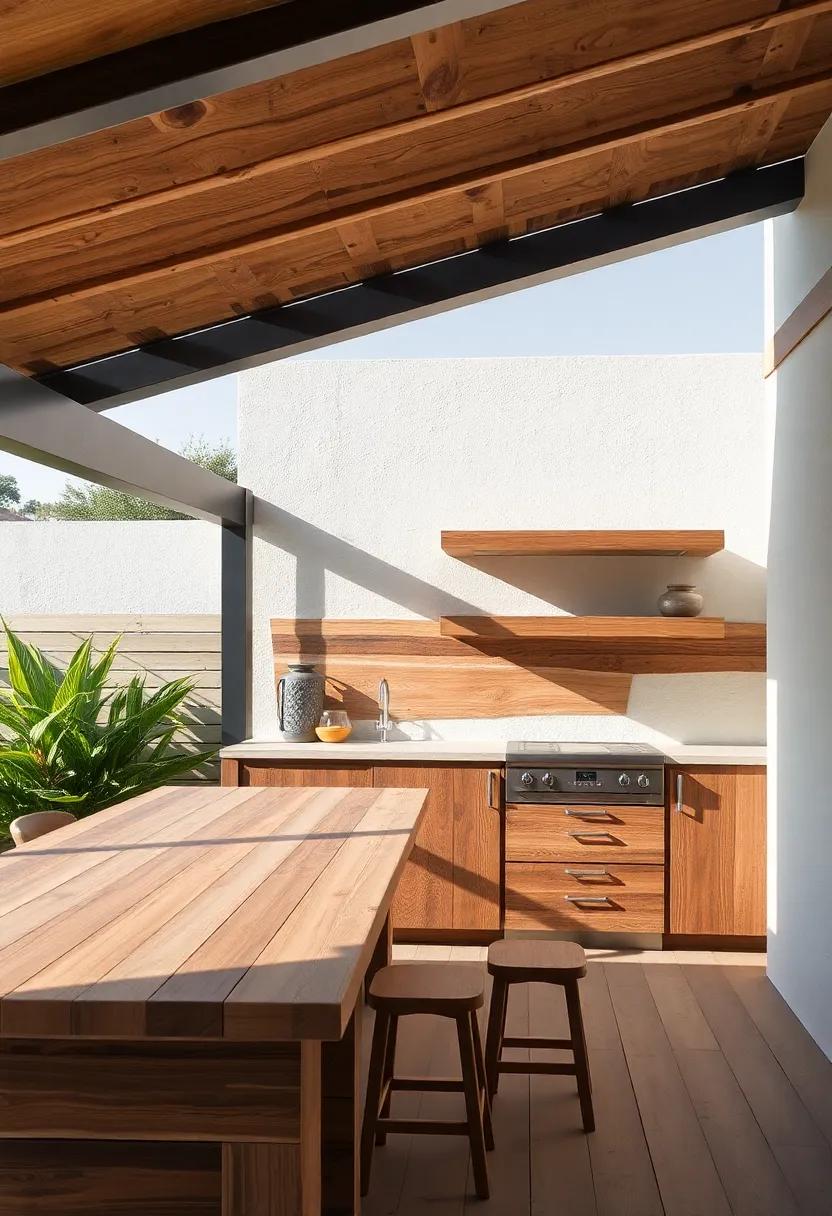
Integrating reclaimed wood into outdoor culinary spaces not only enhances the aesthetic appeal but also champions sustainability. By utilizing materials that have history and character, architects and designers can create unique focal points that tell a story. The natural beauty of reclaimed wood, with its varied textures and rich tones, complements the outdoor environment seamlessly. Furthermore,the ecological benefits of using reclaimed materials include:
- Reduced deforestation: By repurposing wood,we’re lessening the demand for new lumber.
- Lower carbon footprint: The process of recycling wood requires less energy compared to manufacturing new materials.
- Water conservation: Reclaimed wood typically requires minimal processing, conserving precious water resources.
Moreover, reclaimed wood possesses a unique resilience that often surpasses newly sourced timber, making it especially suitable for outdoor use. Its aging process can increase durability while creating visually captivating surfaces.When incorporated into features such as countertops, shelving, or cabinetry, it not only serves functional purposes but also contributes to an eco-conscious design ethos. A comparison table summarizes some commonly used reclaimed wood types:
| Wood Type | Characteristics | Ideal Use |
|---|---|---|
| Barn Wood | Weathered, rustic look | Countertops, tables |
| Teak | Water-resistant, durable | Outdoor furniture, cutting boards |
| Pine | lightweight, easy to work with | Cabinetry, shelving |
Incorporating live Edges for a Unique Touch in Wooden Kitchen Surfaces
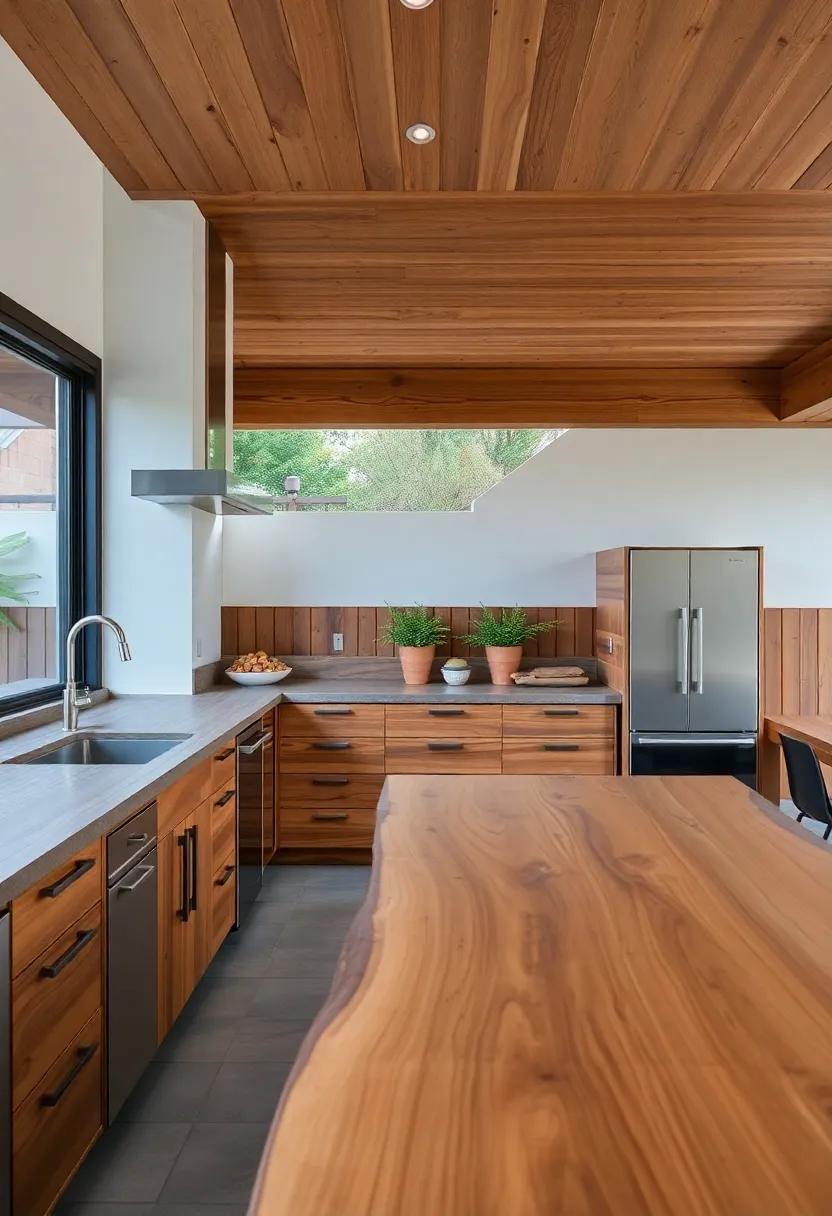
Embracing the natural beauty of timber, incorporating live edges in your wooden kitchen surfaces can elevate the visual appeal of your outdoor culinary space. Live edges preserve the organic contours of the wood, creating stunning, one-of-a-kind countertops or tables that connect you with nature. When selecting live edge pieces, consider the following features:
- unique Grain Patterns: Each piece tells its own story, showcasing intricate knots and swirls.
- Textured Surfaces: The contrast between the smooth, polished areas and the raw edges adds depth.
- Natural Finish: A simple oil or wax finish can enhance the wood’s inherent beauty without overshadowing it.
In addition to aesthetics, live edges can be practical for various outdoor kitchen setups. Their irregular forms prompt innovative designs, allowing for multifunctional surfaces that adapt to your culinary needs. Consider using a live edge slab as:
| Purpose | Description |
|---|---|
| prep Station | A spacious area to chop and prepare ingredients, blending beauty with function. |
| Dining Surface | Perfect for casual outdoor dining, showcasing the natural elegance of wood. |
| serving Platter | utilize as an eye-catching serving board for gatherings and barbecues. |
Exploring Various Wood Species: Choosing the Right Type for Your Kitchen
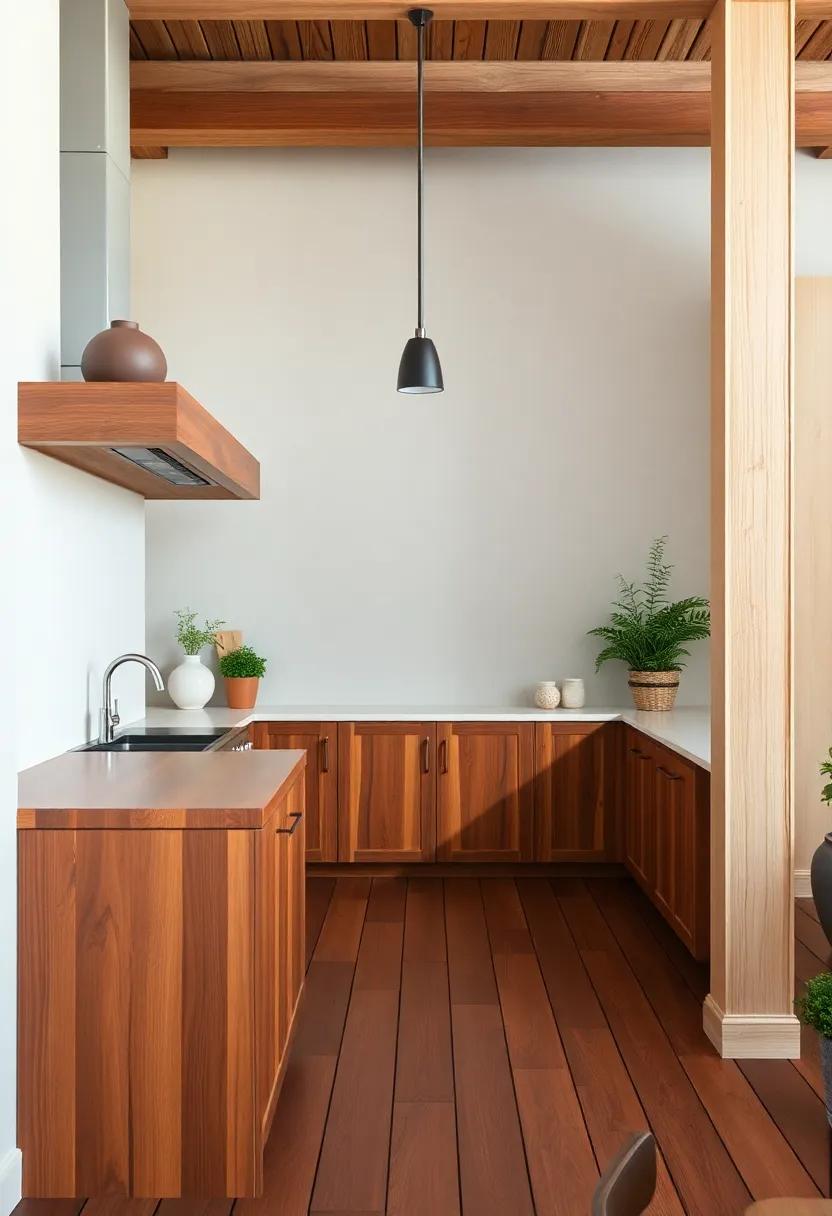
when designing an outdoor kitchen,the choice of wood species can profoundly influence both aesthetics and functionality. Popular options like Teak, Cedar, and Mahogany stand out not just for their beauty but for their resilience against the elements. Teak, known for its rich golden hues and natural oils, is both waterproof and resistant to decay, making it ideal for countertops and cabinetry.Cedar, with its distinct aroma and natural insect-repelling properties, adds a rustic charm while allowing for easy maintenance. On the other hand, Mahogany offers a deep, luxurious finish that complements any outdoor setting, though it requires regular upkeep to maintain its vibrancy over time.
When making your selection, consider factors such as durability, care requirements, and how each wood type harmonizes with your overall design vision. Below is a comparison of these popular wood species to help you make an informed choice:
| Wood Species | Durability | Aesthetic Appeal | Maintenance |
|---|---|---|---|
| Teak | High | Rich golden tones | Minimal; oil occasionally |
| cedar | Moderate | Warm, rustic appearance | Low; occasional sealing |
| Mahogany | High | Deep, luxurious finish | Moderate; requires regular oiling |
Balancing Functionality and Beauty in Rustic Wooden Kitchen Designs

In the world of rustic wooden kitchen designs, the charm lies not just in aesthetics but also in the practicality these spaces offer. Homeowners often seek to harmonize their culinary environment with elements that are both functional and visually appealing.To achieve this delicate equilibrium, incorporating high-quality materials and thoughtful layouts plays a notable role. Consider the following elements:
- Natural Finishes: Utilizing wood with a rich texture and grain adds warmth, making the kitchen feel inviting.
- Smart storage Solutions: Incorporating built-in shelving and cabinets that mimic rustic charm while maximizing space efficiency.
- Outdoor Integration: creating a seamless flow from the indoor kitchen to outdoor spaces, enhancing the overall cooking experience.
Moreover, the integration of various functional features can elevate the rustic feel while ensuring longevity and usability.For example, enhancing countertops with durable wood types that withstand outdoor elements serves both beauty and practicality. Here’s a brief overview of some popular wood choices:
| Wood Type | Durability | Maintenance |
|---|---|---|
| Teak | High | Low |
| Cedar | medium | Medium |
| Red Oak | Medium | High |
Creating Culinary Retreats with Custom Wooden Features and Layouts
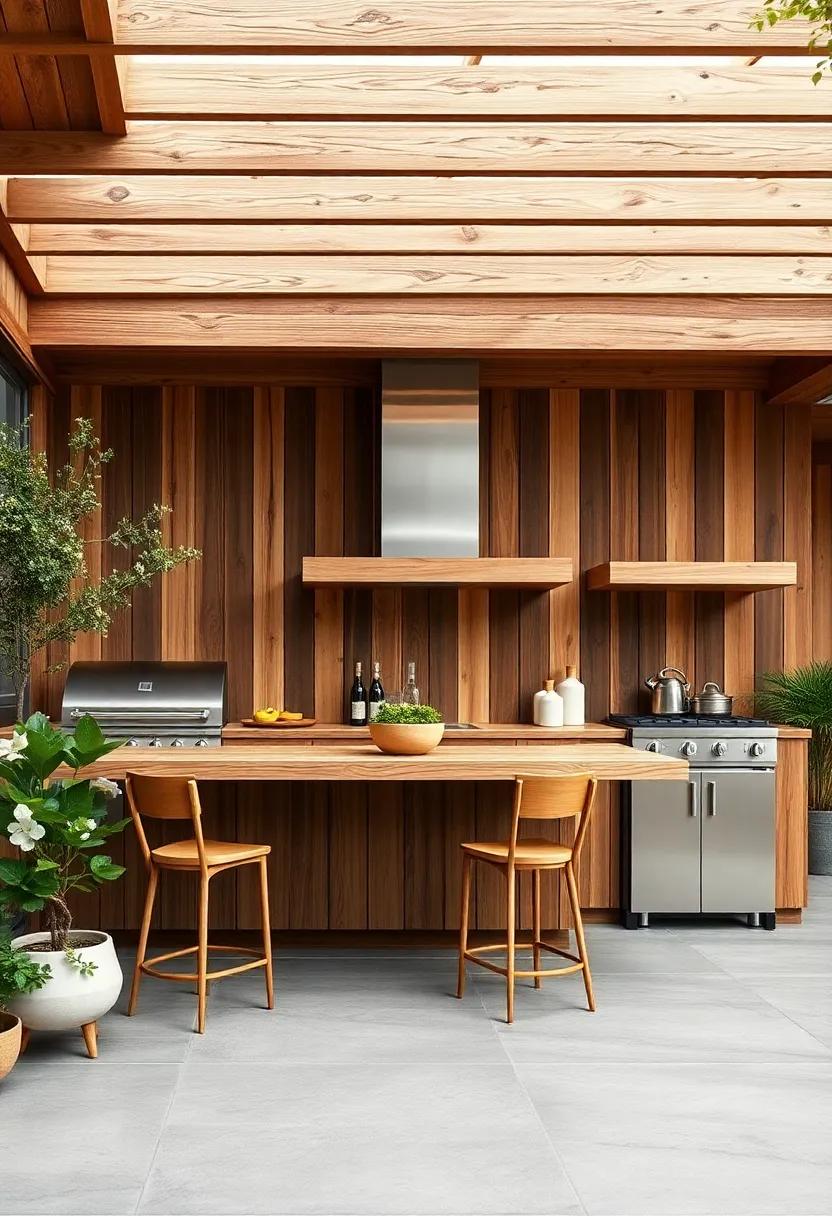
Transforming an outdoor space into a culinary retreat begins with the thoughtful integration of custom wooden features that harmonize functionality and aesthetics. Imagine a sprawling wooden deck adorned with a handcrafted outdoor kitchen, where the rich textures of natural wood contrast beautifully with lush greenery. Here, customized wooden cabinetry can house your utensils and spices while providing easy access to all essentials needed for a delightful cooking experience. Surround the kitchen with a built-in wooden dining area,offering a welcoming space for family and friends to gather,share,and enjoy the fruits of your labor.
To further enhance the charm of your culinary oasis, consider incorporating unique wooden elements that reflect your personality. Key features might include:
- Rustic wooden beams framing your outdoor space, lending a sense of sturdiness and warmth.
- Artisan-crafted tables showcasing local timber, ideal for alfresco dining or food presentation.
- Custom shelving made of reclaimed wood to display herbs, plants, and kitchen essentials within arm’s reach.
This bespoke approach not only elevates the overall aesthetic but also fosters a deeper connection with nature, transforming outdoor cooking into a cherished lifestyle experience.
Integrating Wood with Modern Appliances for a Cohesive Look
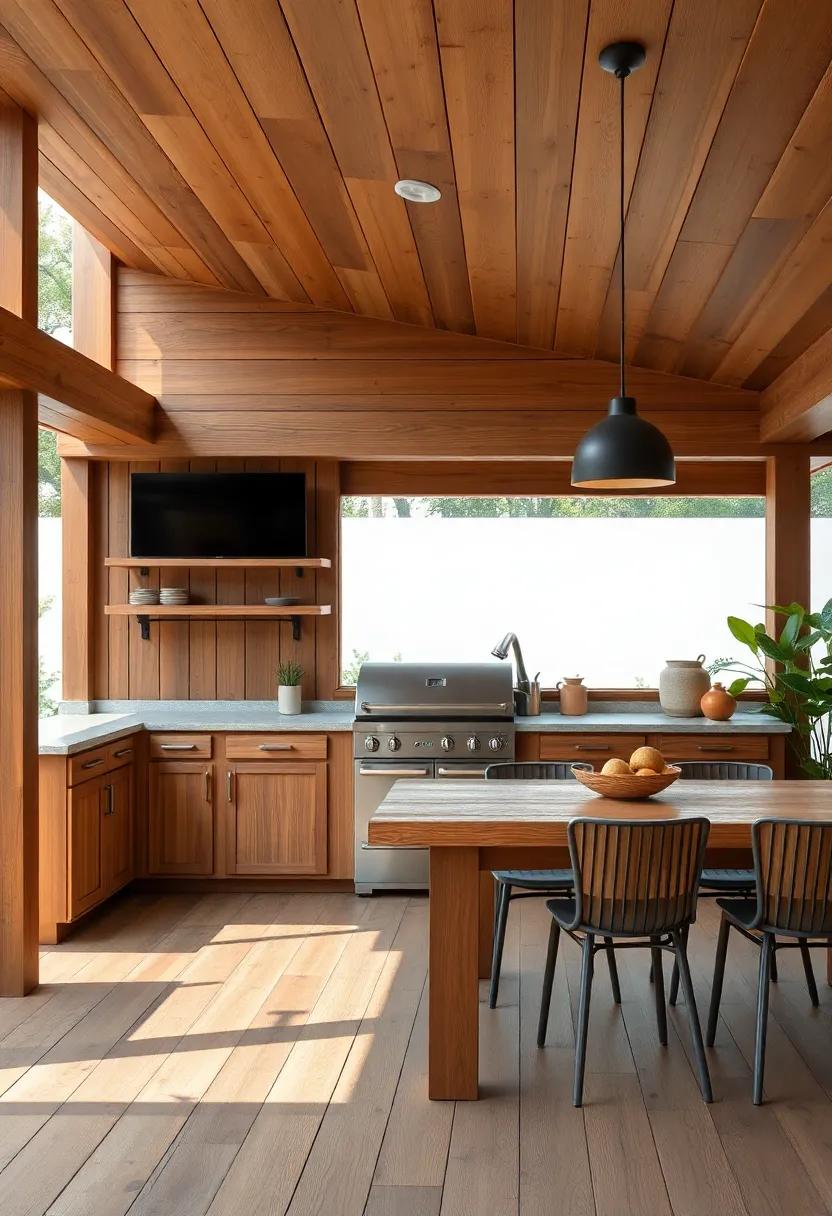
Incorporating wood elements into outdoor kitchen design not only enhances aesthetics but also integrates seamlessly with modern appliances. The soft warmth of wood can beautifully contrast with the sleek surfaces of stainless steel or glass. Consider the following features for a cohesive look:
- Wooden Cabinetry: Custom cabinets made from rich hardwoods can frame your high-tech appliances, adding character while maintaining functionality.
- Countertops: A butcher block or live-edge wooden countertop can act as a natural centerpiece, cleverly juxtaposing a stainless steel grill or refrigerator.
- Accent Walls: Using a vertical wood paneling design around appliances can create a sense of continuity, making modern features feel less intrusive.
Moreover, integrating lighting designs can further enhance the harmony between wood and modern elements. Pendant lights with wooden accents or under-cabinet lighting can highlight the beauty of wood while providing a functional ambiance. Below is a simple comparison of materials that can elevate your outdoor kitchen experience:
| Material | Benefits | Best Use |
|---|---|---|
| Wood | Warmth, aesthetic appeal, customizable | Counters, cabinetry, accents |
| Stainless Steel | Durability, modern look, easy maintenance | Appliances, sinks, finishes |
| Glass | Transparency, modern style, easy to clean | Backsplashes, bar areas |
Showcasing the Beauty of Natural Grain Patterns in Outdoor Cooking Spaces
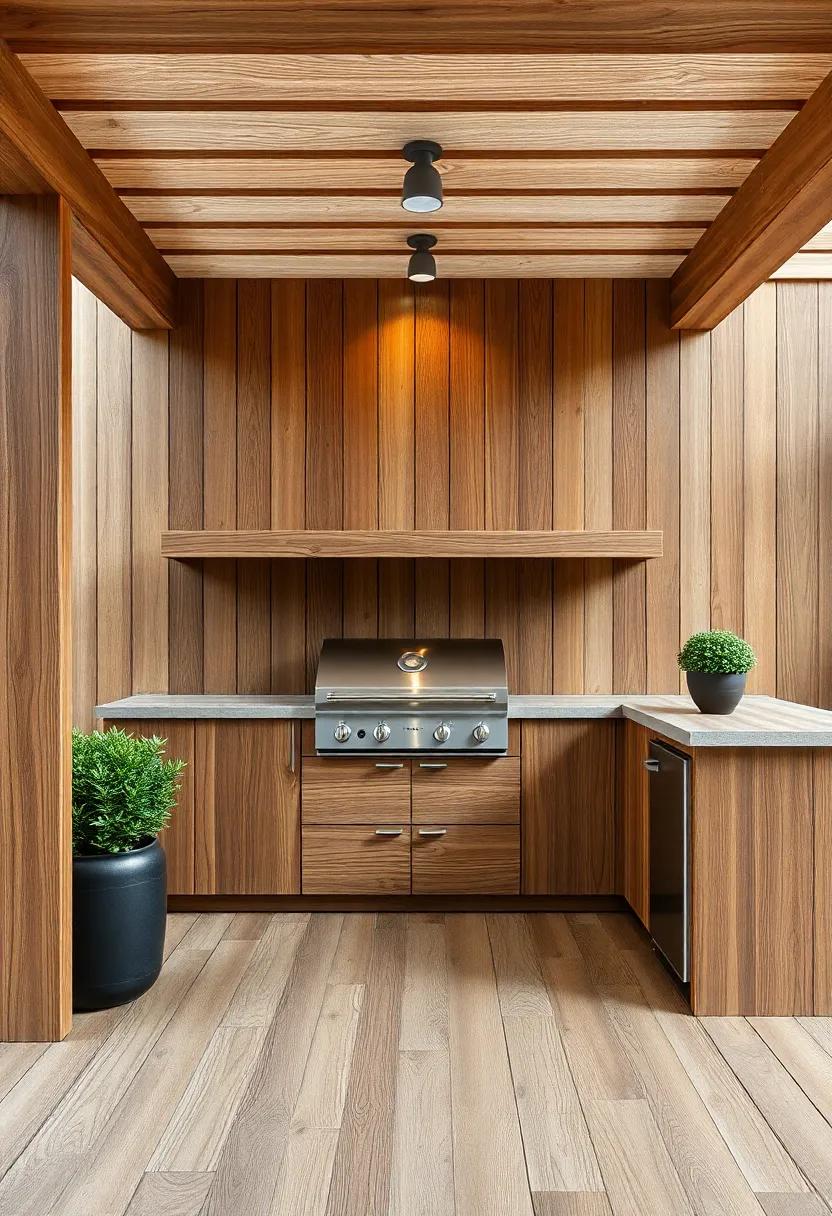
The essence of outdoor cooking spaces is frequently enough defined by the natural beauty of wood, notably through its rich grain patterns. Each piece of timber tells its own story, with unique swirls and knots that add depth and character. These natural variations not only enhance the aesthetic appeal but also evoke a sense of harmony with the surrounding environment. Consider using hardwoods like teak or mahogany, renowned for their durability and resistance to the elements, ensuring that the stunning grain remains visible season after season. The interplay of light and shadow on these surfaces can create a mesmerizing backdrop for culinary creativity.
Incorporating wood into your outdoor kitchen design can transform it into a complex yet inviting retreat. The use of wood can be varied – from countertops and cabinetry to accents in furniture and decorative elements. Explore different finishes to enhance the natural grain, ranging from matte oils that preserve authenticity to glossy varnishes that provide a contemporary twist. To illustrate different wood types and their characteristics,a brief comparison might include:
| Wood Type | Durability | Grain Pattern | Recommended use |
|---|---|---|---|
| Teak | High | Intertwined | Countertops,Decking |
| Cedar | Medium | Striped | Cabinetry,Accents |
| Red Oak | High | Visible Rays | Furniture,Beams |
| Maple | Medium | Sleek and Smooth | countertops,Shelving |
With thoughtful selection and design,wood can be the centerpiece of your outdoor cooking haven,celebrating both functionality and nature’s artistry.
Designing Versatile outdoor Kitchen Islands with Wood as the Focal Point
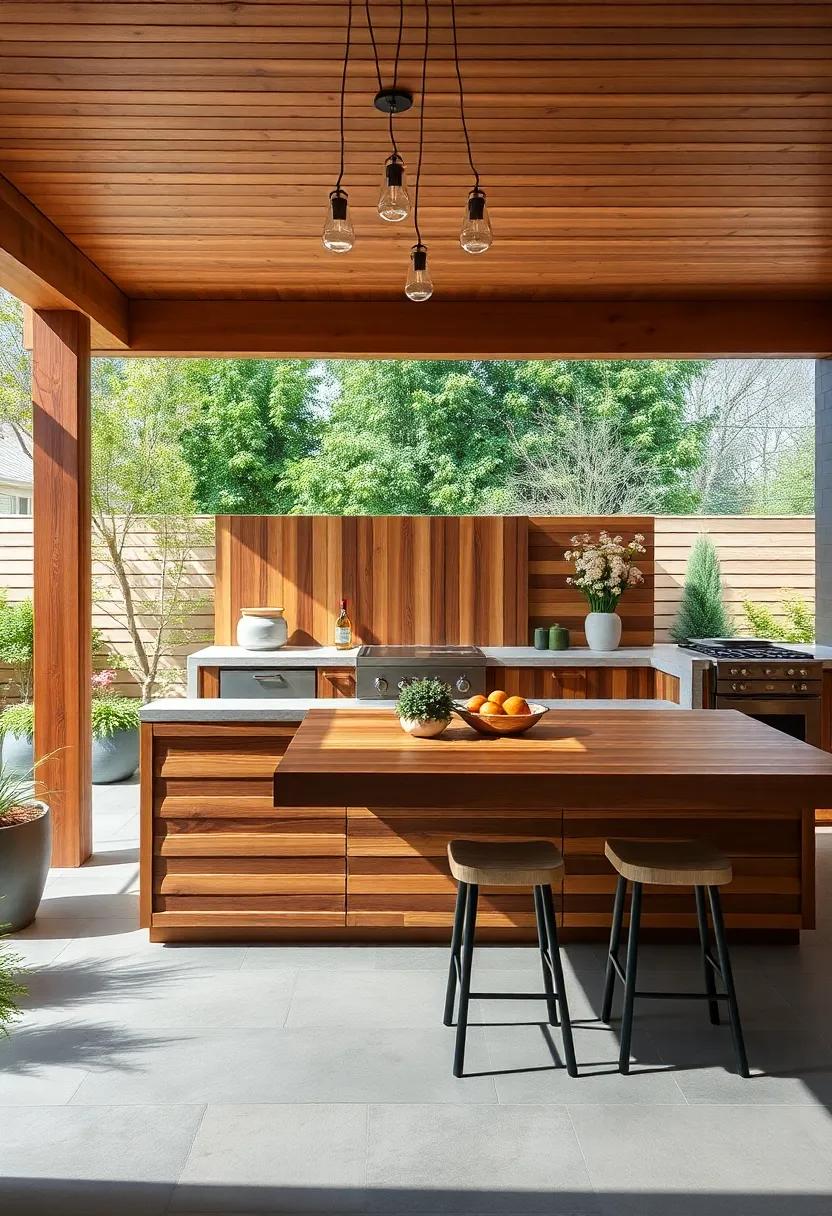
When creating an outdoor kitchen island,wood serves as an exceptional focal point that seamlessly bridges the gap between nature and functionality. The natural beauty and warmth of wood not only enhances the aesthetic appeal of the outdoor space but also brings a sense of coziness. Whether you opt for a sleek modern design or a rustic farmhouse vibe, the use of materials like cedar, teak, or oak can introduce a layer of sophistication and elegance. Key features to consider include:
- Countertops: Choose durable, weather-resistant wood finishes that can withstand the elements without losing their charm.
- storage Solutions: Incorporate wooden cabinets or shelves to maintain a harmonious look while providing adequate space for utensils and cooking supplies.
- Seating Arrangements: Build in comfortable wooden stools or benches that encourage social gatherings and outdoor dining.
Integrating wood also allows for an array of customizable designs tailored to personal preferences and lifestyle. Consider contrasting your wooden elements with stainless steel or stone appliances for a striking visual balance that enhances usability. to further elevate the appeal, adding decorative accents like built-in herb gardens or ambient lighting can transform the space into a welcoming retreat. Below is a simple layout to help visualize your outdoor kitchen island:
| Wood Type | Benefits | Ideal Use |
|---|---|---|
| Cedar | Natural resistance to decay and pests | Countertops & Shelves |
| Teak | Highly durable, weather-resistant | Seating & Grill Enclosures |
| Oak | Strong, classic look | Cabinets & Structural Elements |
Enhancing Culinary Experiences with Artistic Wooden Accents
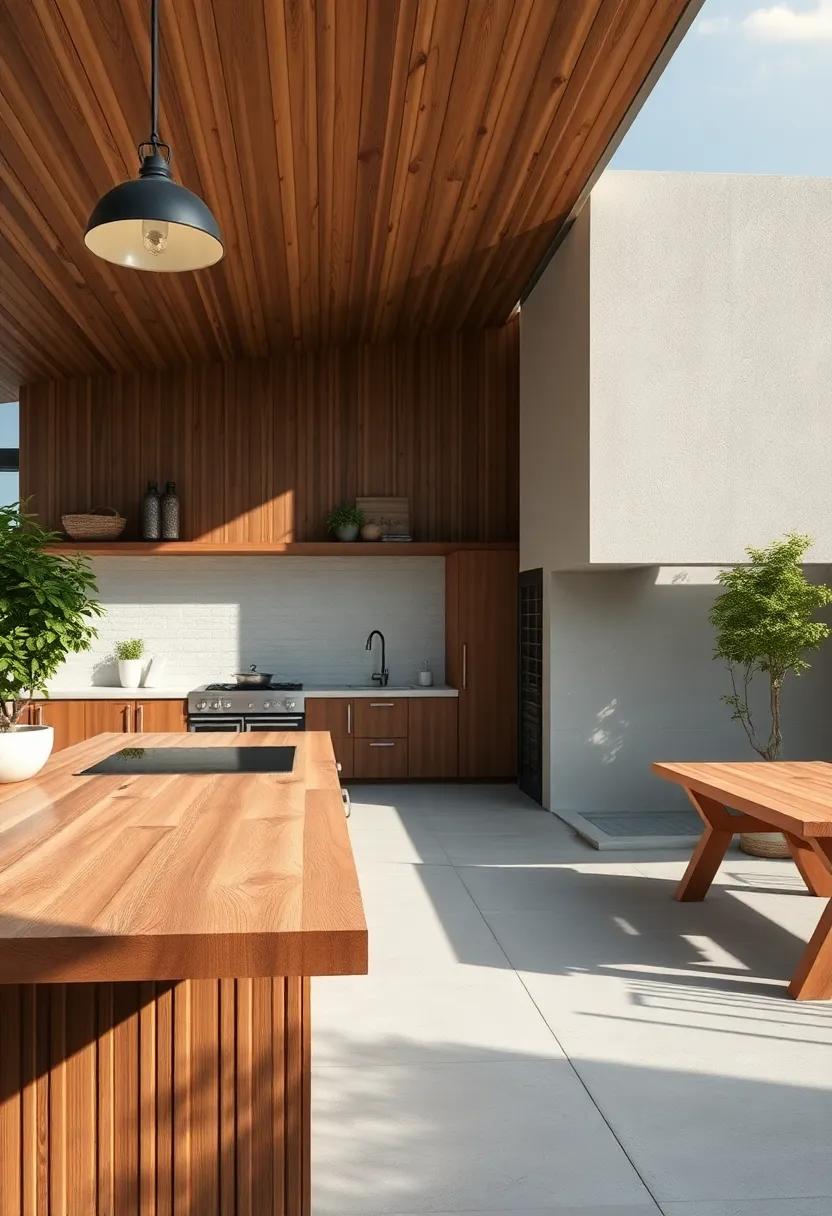
In the realm of outdoor kitchen design, the use of artistic wooden accents elevates not only the aesthetics but also the sensory experience of cooking and dining al fresco. from intricately carved cabinetry to rustic wooden countertops, these elements infuse warmth and charm, making open-air spaces feel inviting and cohesive with nature. Incorporating natural grain patterns and organic shapes, the right wood pieces become more than just functional; they serve as conversation starters and focal points that marry form and function beautifully.
Consider integrating wooden features that accentuate the culinary journey. Some ideas include:
- Custom butcher blocks: Perfect for food prep and adding a touch of artisanal craftsmanship.
- Wooden shelving: Display herbs, spices, and kitchen tools while maintaining a rustic vibe.
- Dining table: A solid wood table can serve as a gathering place, promoting communal dining experiences.
- Accent lighting: Wooden lanterns or fixtures can create a warm ambiance as the sun sets.
| Wood Type | Characteristics | Best Use |
|---|---|---|
| Teak | Durable, water-resistant | Countertops, furniture |
| Cedar | Aromatic, insect-repelling | Shelving, planters |
| Maple | Hard, dense | butcher blocks, cutting boards |
By intentionally selecting woods that complement your outdoor kitchen’s design, you can create an environment that not only serves culinary needs but also fosters a sense of tranquility and connection with the outdoors. Each wooden accent, chosen with care, contributes to a harmonious retreat where the experience of cooking becomes as enjoyable as the pleasure of dining beneath the open sky.
Using Wood to Define Spaces in Open-Air Culinary Retreats
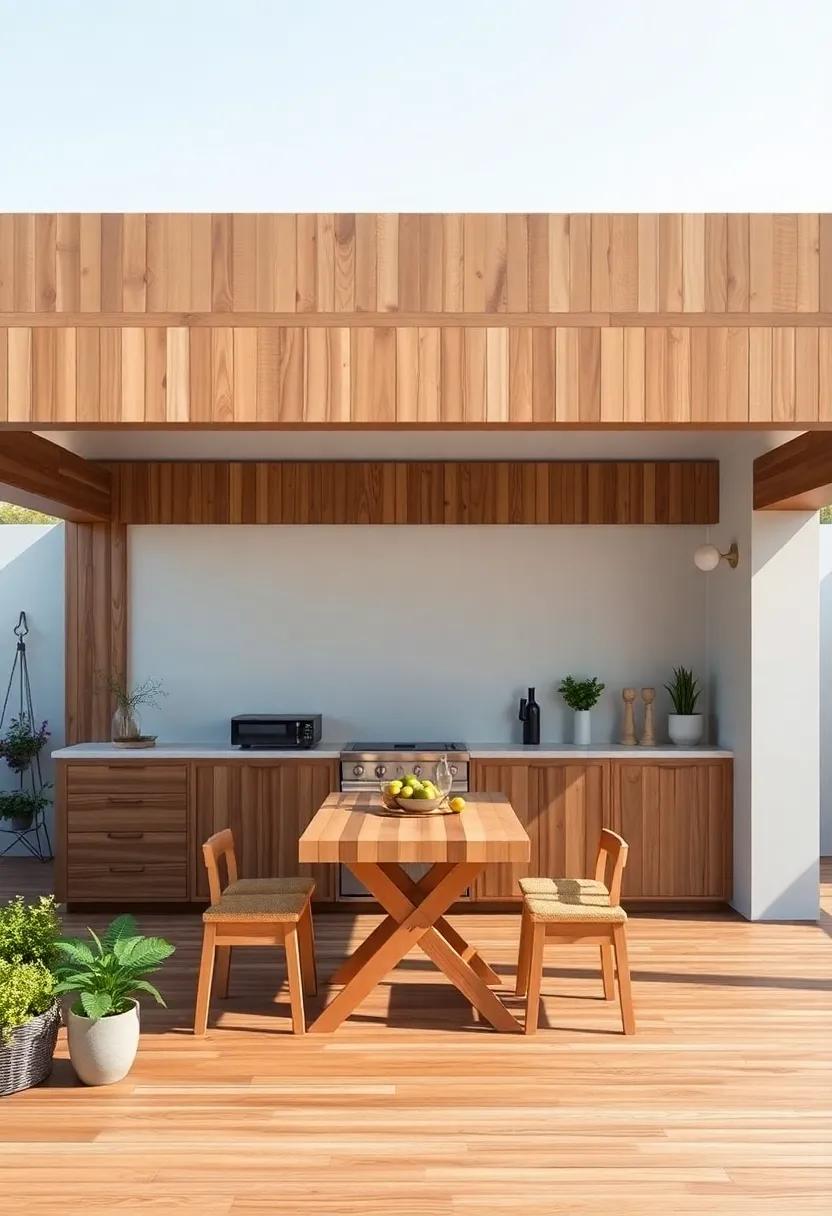
Wood serves as a versatile and natural medium for delineating spaces within open-air culinary retreats, creating both functional zones and inviting atmospheres. By utilizing various forms of wood,from rustic beams to polished planks,designers can effectively establish different cooking,dining,and relaxation areas. Consider the use of wooden screens, planters, and benches that not only blend seamlessly with the surrounding environment but also offer practical solutions for association and flow.By incorporating traditional techniques,such as shou sugi ban (charred wood) for weather resistance and aesthetic appeal,each section can maintain its uniqueness while contributing to a cohesive design language.
Creating distinct yet harmonious spaces can also be enhanced by employing wooden elements in innovative ways. Such as, raised platforms made from reclaimed timber can define cooking stations or dining areas, providing a visual cue that guides guests through the retreat. Additionally, overhead structures, such as trellises or canopies, crafted from strong yet lightweight wooden frames, offer shelter while adding vertical interest. A well-placed
| Wood Element | function |
|---|---|
| Decking | Defines dining area |
| Wooden Barrels | Outdoor seating |
| Shelving Units | Displays culinary herbs |
can bring a rustic charm while being practical, creating enchanting corners for culinary exploration, social interaction, and connecting with nature.
Incorporating Built-in Wood Seating for Comfort and Style
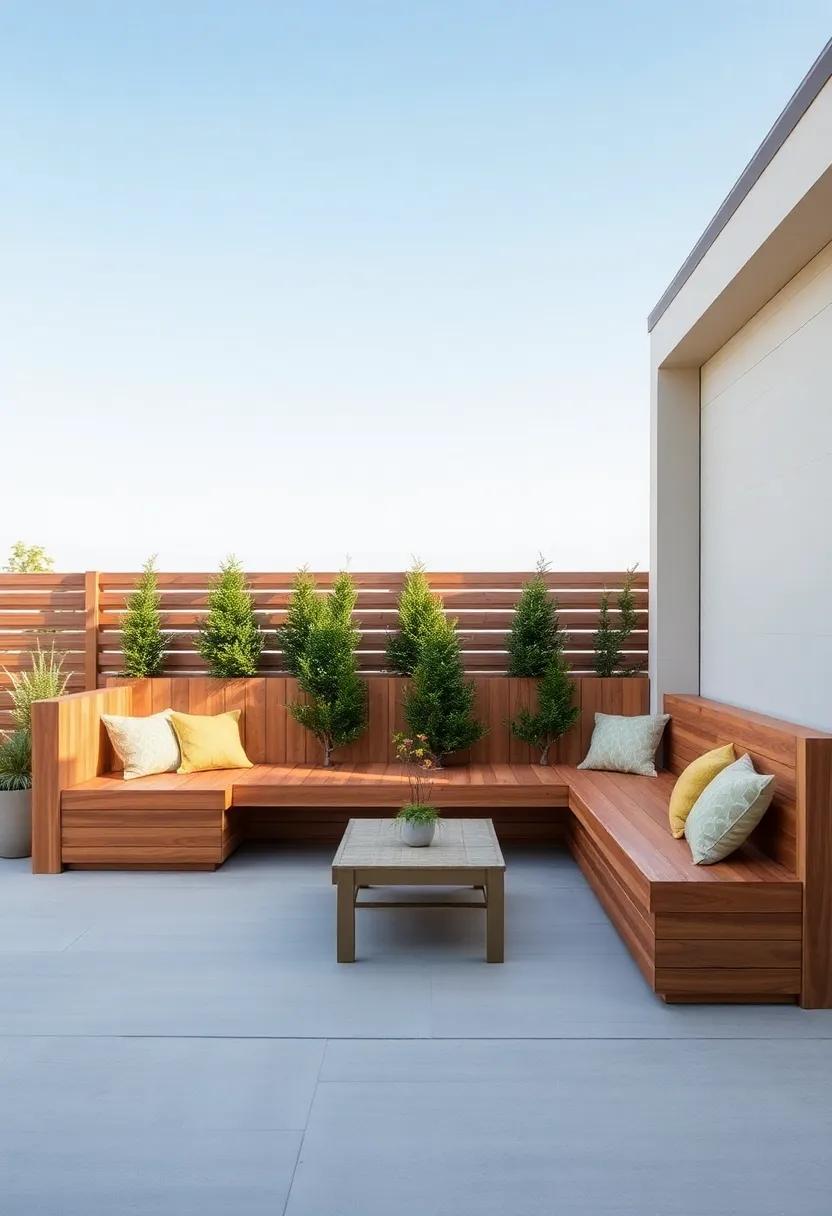
Embracing the natural charm of wood in outdoor kitchens extends beyond just countertops and cabinetry; it invites the chance to integrate built-in seating that enhances both comfort and aesthetic appeal. Imagine a warm, inviting setup where guests can gather around a beautiful wooden bar, seamlessly blending functionality with elegant design. Creating cohesive seating arrangements can transform outdoor spaces into engaging social hubs, perfect for hosting intimate dinners or lively gatherings. Consider using *reclaimed wood* for its rustic allure or *teak* for its durability, each option offering unique character while ensuring longevity against the elements.
The design flexibility of wood seating is another compelling advantage. Choose from a variety of styles to suit your personal taste and outdoor theme, such as:
- Built-in benches: designed for maximum space efficiency, ideal for smaller areas
- Bar stools: perfect for elevated dining experiences around high tops
- Chairs with cushions: providing extra comfort for extended gatherings
To elevate the style quotient, incorporate contrasting colors or cushions that complement the natural tones of the wood. A well-thought-out arrangement not only encourages conversation but also ensures that family and friends feel at home, forging lasting memories around the grill or pizza oven.
Blending Indoor and Outdoor Spaces with Seamless wooden Design
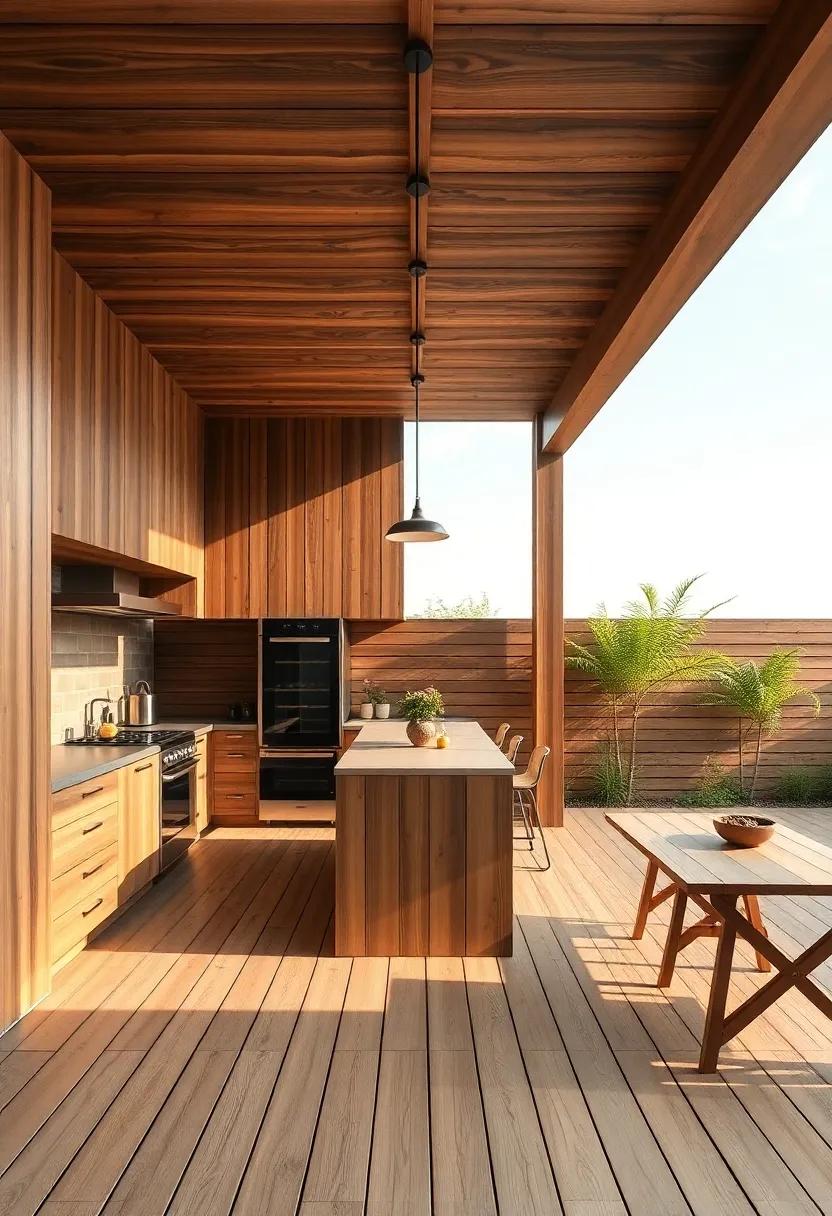
Seamlessly integrating indoor and outdoor spaces can transform an ordinary kitchen into a delightful culinary haven. By utilizing wooden elements, you can establish a harmonious flow that blurs the boundaries between your indoor cooking area and the outdoor culinary retreat. Choose rich, natural wood tones for countertops and cabinetry; they create a cohesive aesthetic that invites the warmth of nature indoors. Incorporating large windows, sliding glass doors, or open archways finished with timber frames will allow for a breathtaking view of your outdoor landscape while welcoming in the calming sounds of nature—these features can make your cooking experience feel expansive and enjoyable.
To enhance this connection, consider the use of complementary materials and decor that evoke a sense of unity across both spaces. Integrate outdoor seating and dining areas that feature weather-resistant wooden furniture, designed to match the indoor style. This can create an inviting space for family gatherings or entertaining guests. Additionally, using a consistent color palette of earthy tones and organic textures will further tie together the aesthetic. Here are some key elements to consider:
- Natural Wood Finishes: Select sustainable woods such as cedar or teak for their durability and appealing grain.
- Open Layouts: Promote seamless transitions with open-plan designs that facilitate movement between spaces.
- Outdoor Appliances: Incorporate wooden accents around grills and outdoor kitchens for a unified look.
Crafting Cozy Cooking Corners with Natural Wood Finishes
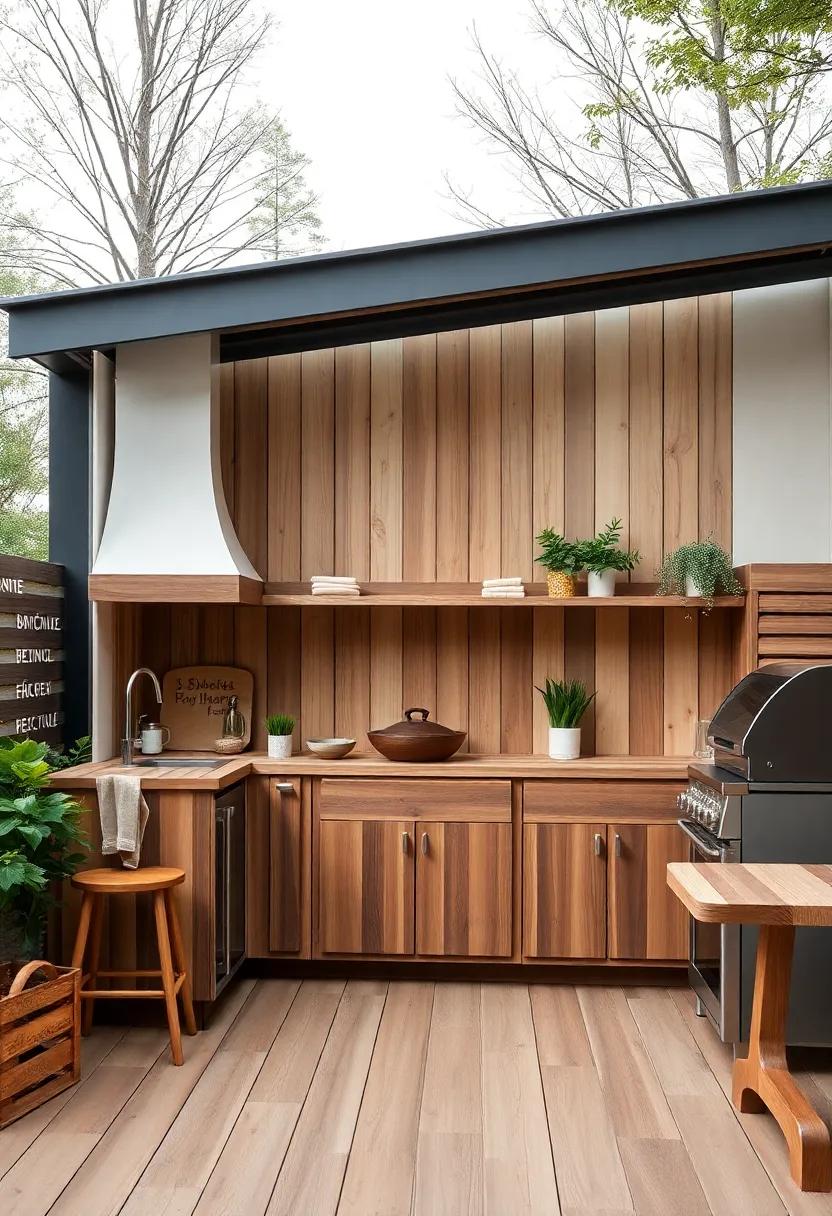
Transforming outdoor kitchens into inviting culinary retreats requires a thoughtful touch, especially when it comes to materials. Natural wood finishes bring a warm, rustic charm that not only enhances the aesthetic appeal but also creates a tactile experience, drawing people into the heart of the culinary space. With a variety of wood types to choose from, each offering its unique hue and grain, you can achieve a look that feels organic and comforting. Consider incorporating elements such as:
- Wooden countertops that not only serve practicality but also act as a centerpiece.
- Open shelving made from reclaimed timber, displaying herbs and spices in a visually pleasing manner.
- Natural wood finishes on cabinetry that can withstand the elements while providing a traditional touch.
when planning your cozy cooking corners, think about creating distinct zones where wood plays a central role. An outdoor island encased in weather-treated wood can double as a dining area, merging function with style. This not only enhances usability but invites guests to gather and enjoy the ambiance of cooking outdoors. To further enrich this design, consider the following:
| Wood Type | Benefits |
|---|---|
| Teak | Highly resistant to moisture; ideal for outdoor settings. |
| cedar | Natural insect repellent; aromatic and visually appealing. |
| Bamboo | Sustainable choice; adds a modern twist with its unique look. |
By harmonizing these elements, your outdoor kitchen will not only become a practical cooking area but also a serene place where culinary creativity flourishes against the backdrop of nature’s beauty.
Elevating Outdoor Dining with Elegant Wooden Furniture and Fixtures
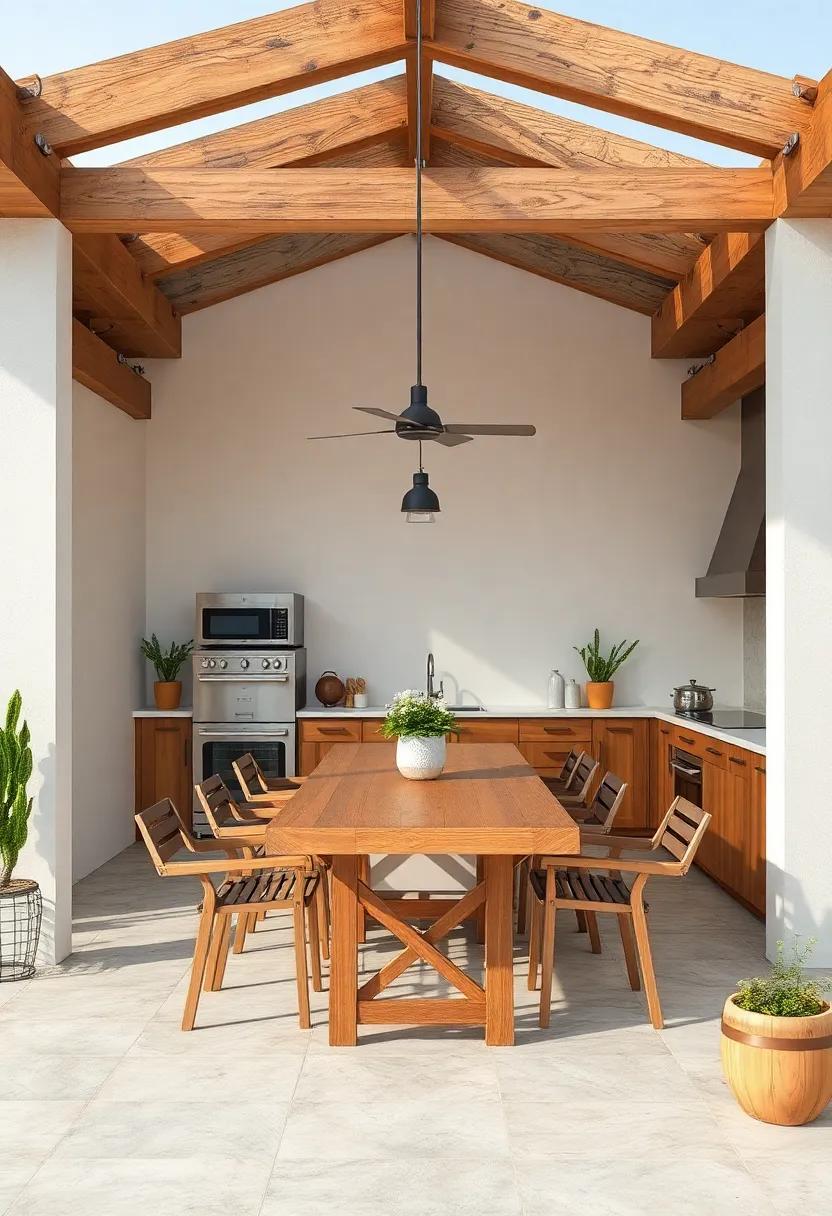
Outdoor dining experiences are enriched by the presence of striking wooden furniture and fixtures, which perfectly complement the natural beauty of outdoor spaces. With a fusion of craftsmanship and functionality, wooden elements such as dining tables, benches, and rustic bar stools elevate the aesthetic appeal. These pieces not only serve as practical seating but also create an inviting atmosphere that encourages relaxation and connection with nature. The rich textures and warm hues of wood provide a soothing backdrop for culinary delights, inviting diners to savor every moment of their outdoor experience.
When considering the design of outdoor kitchens, integrating wooden features can vastly enhance both the visual and functional aspects. Think of open-air cabinets,stylish serving stations,and decorative trellises that bring a sense of charm to your culinary retreat. The versatility of wood allows for customization to suit various styles, from contemporary designs to classic rustic looks. Additionally, utilizing treated or reclaimed wood options can ensure durability against the elements while promoting sustainability. Here’s a simple overview of some wooden features that can transform your outdoor space:
| Feature | Benefits |
|---|---|
| Dining Tables | Creates a focal point for meals; durable and timeless. |
| Benches | Offers flexible seating; complements outdoor landscaping. |
| Bar Stools | Adds height variety; ideal for socializing over drinks. |
| Cabinetry | Provides storage; blends functionality with style. |
| Trellises | Enhances visual interest; supports climbing plants. |
Exploring Innovative storage Solutions with Wood in Outdoor Kitchens
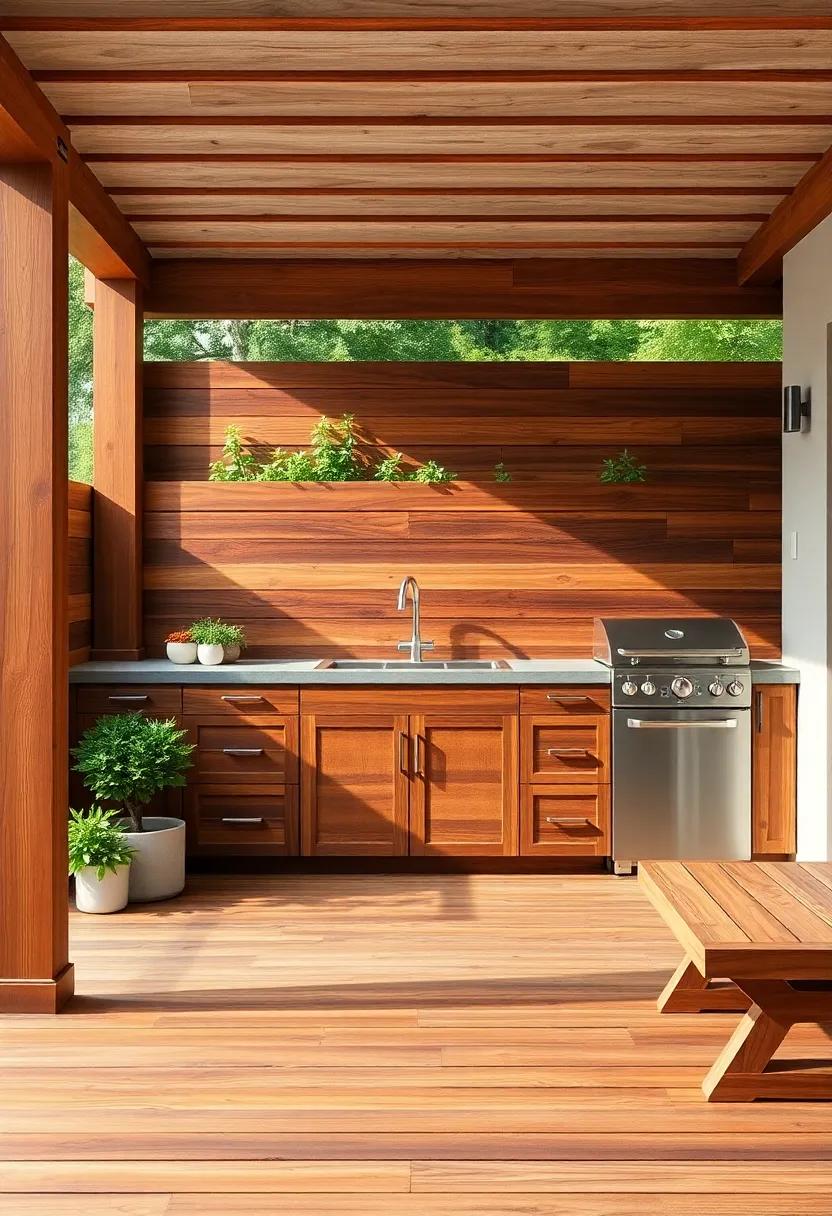
When it comes to outdoor kitchens, the marriage of functionality and aesthetics is crucial, and wood plays a versatile role in enhancing both. By incorporating innovative storage solutions crafted from wood, homeowners can achieve an organized and inviting culinary space.Consider features such as:
- Wooden Cabinets – Custom cabinets can provide ample storage while complementing the natural surroundings.
- Drawer Systems – Pull-out wooden drawers can be designed for easy access to utensils, spices, and grilling tools.
- open Shelving – Sturdy wooden shelves showcase beautiful dishware and fresh herbs, adding character and charm.
Moreover, the creative use of wood extends beyond typical cabinetry. As a notable example, multi-functional furniture pieces, such as benches with built-in storage, offer both comfort and practicality. Adding a touch of innovation, you can integrate features like:
- Wooden Sliding Panels – Concealing appliances like grills or sinks to maintain a clean aesthetic when not in use.
- Outdoor Serving Carts – Portable wooden carts provide mobility to your serving and storage needs during gatherings.
- Vertical Gardens – Wooden planter boxes can be integrated for herb gardens, combining functionality with greenery.
Capturing the Essence of Nature Through Wooden Design Elements
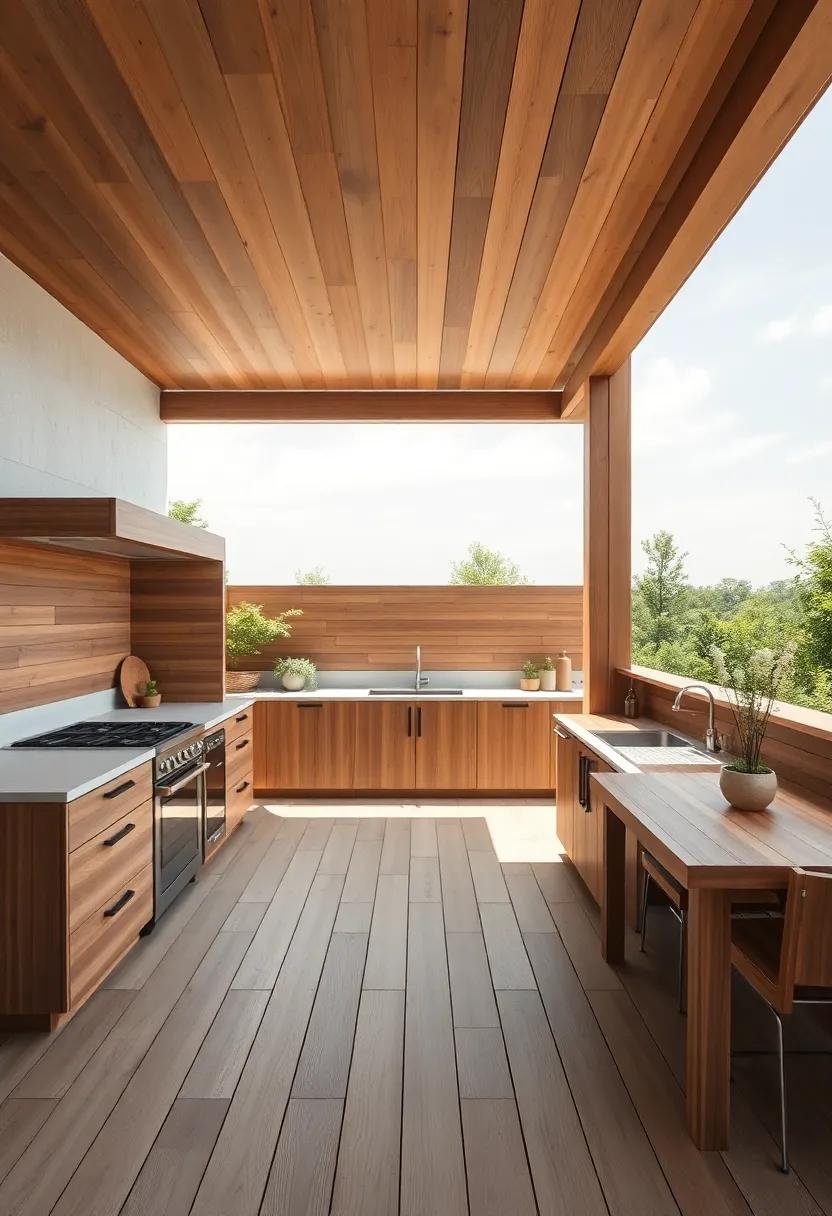
In the realm of outdoor kitchen design, wood serves as a powerful medium for enhancing the connection between culinary spaces and the natural world. Its organic warmth and diverse textures can transform a simple kitchen into an inviting culinary retreat.The inspiration derived from nature informs every element, from the handcrafted cabinetry to the rugged countertops. The versatility of wood allows for endless creativity, whether employing reclaimed timber for a rustic charm or sleek bamboo for a contemporary feel. Wood embellishments can include:
- Custom Cutting Boards
- Natural Wood Shelves
- Exposed wooden Beams
- Rustic Stools and Seating
Moreover, the relationship between wood and outdoor kitchens promotes sustainability and eco-friendliness. Utilizing responsibly sourced materials not only showcases a commitment to the environment but also infuses spaces with local heritage. The inherent characteristics of wood, such as its scent and tactile appeal, play a crucial role in creating moments of tranquility and inspiration. Integrating living elements, such as herb planters crafted from wood, deepens this connection, providing both beauty and functionality. Below is a summary of some ideal wood choices for outdoor kitchen projects:
| Wood Type | Benefits |
|---|---|
| Teak | Durable, water-resistant, ideal for outdoor use |
| Cedar | Natural insect repellent, aromatic, lightweight |
| Redwood | Resistant to decay, long-lasting, beautiful red hue |
Integrating Water Features and Wood for a Tranquil Cooking Environment
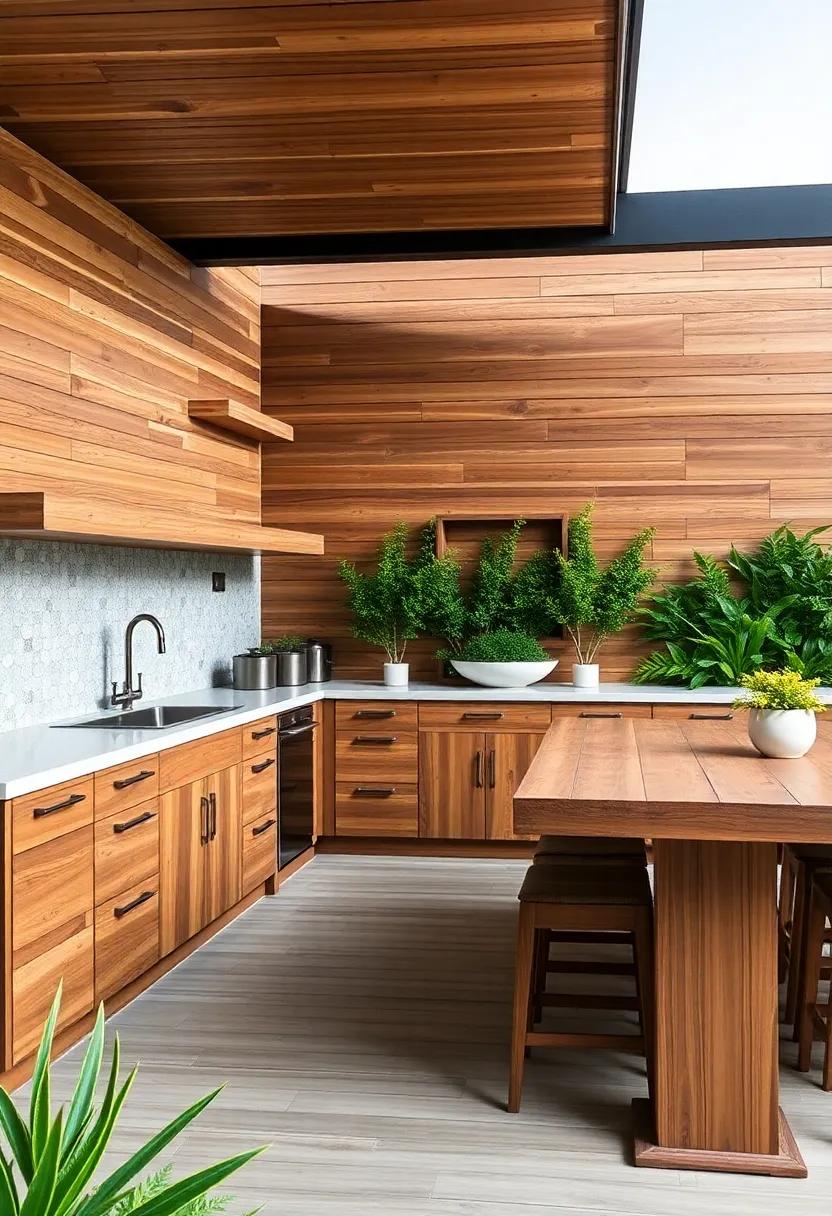
The harmonious combination of water features and wood can create an inviting ambiance in your outdoor kitchen. Imagine the soothing sounds of a trickling fountain paired with the rich, warm tones of natural wood. This dynamic duo not only enhances the beauty of the space but also promotes a sense of tranquility. When designing your culinary retreat, consider the following elements:
- Integrating a water Element: A small pond or fountain adds visual interest and relaxation.
- Wooden Decking: use sustainable wood for a naturally aesthetic and slip-resistant surface.
- Seating Areas: Incorporate wooden benches near water features to maximize comfort and enjoyment.
Incorporating wood in structures, such as pergolas or table settings, complements water elements beautifully and creates a natural flow.Balance is key; you might opt for a stone base around a wooden dining area, allowing the water features to stand out while remaining grounded in earthy textures. Below is a simple comparison of different water features to consider integrating into your space:
| Water Feature | Wood Pairing | Benefit |
|---|---|---|
| Fountain | Cedar Table | Enhances ambiance |
| pond | Wooden Deck | Inviting, natural feel |
| Water Wall | ipe Slabs | Visual impact |
Celebrating the Texture and Resilience of Wood in culinary Retreats
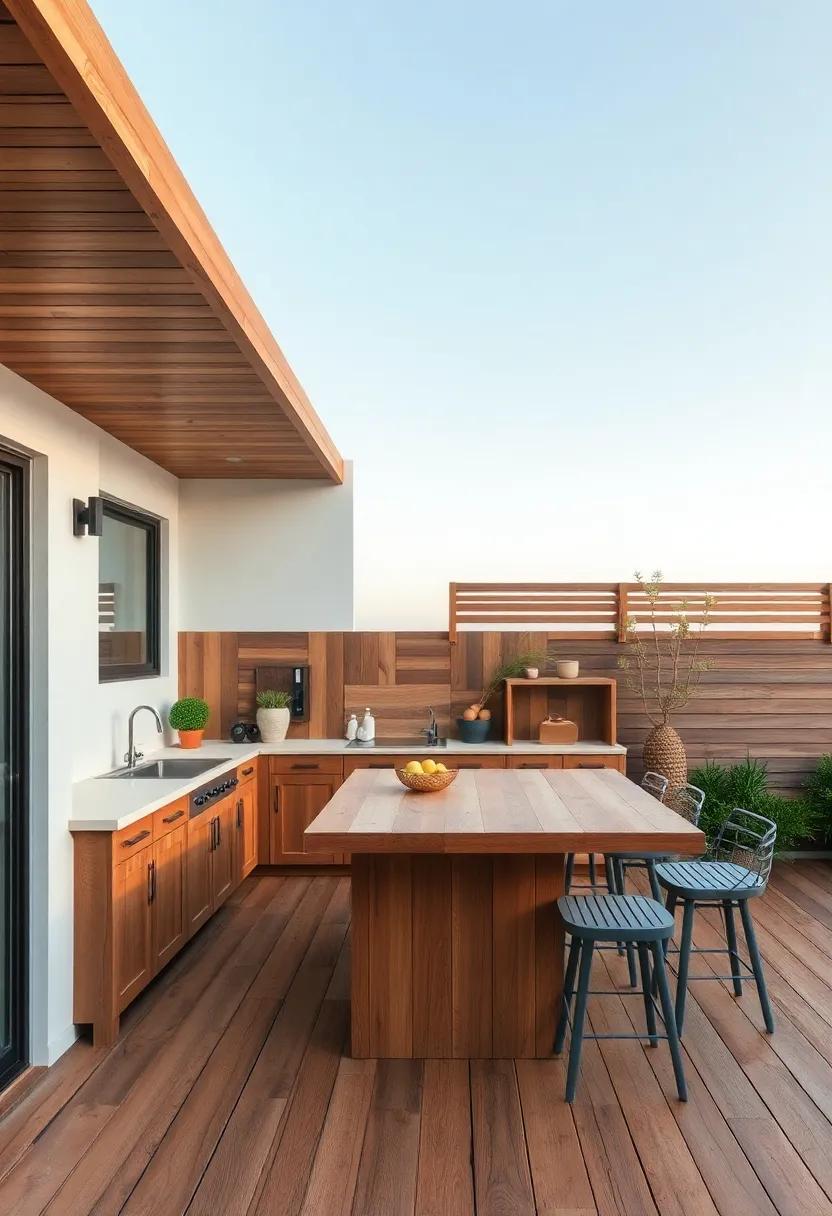
In the realm of culinary retreats, wood emerges as more than just a construction material; it embodies the very spirit of the outdoors. Each piece of wood tells a story, its unique grain and texture whispering tales of the trees from which they came. From rustic cedar countertops to elegant oak cabinetry,the variations in color and texture create an inviting atmosphere that enhances the cooking experience. As chefs work in these wood-laden kitchens, their senses are engaged, connecting them to the earth and inspiring creativity. The warmth of wood fosters a sense of tranquility,making it the perfect companion for gathering around a shared meal.
The resilience of wood in outdoor kitchen design is a testament to its natural durability and adaptability. When treated properly, wood can withstand the elements, providing longevity without sacrificing beauty. Consider incorporating the following elements to elevate the culinary retreat experience:
- natural Finishes: Use oils and sealants that highlight the wood’s grain while protecting it from moisture and UV rays.
- Mixed Textures: Combine smooth finishes with rough-hewn surfaces to create visual interest and tactile variety.
- Functional Design: Opt for wooden shelving and storage solutions that reflect the retreat’s aesthetic while offering practicality.
To further illustrate the versatility of wood, here’s a simple overview of ideal wood types for specific outdoor kitchen features:
| Wood Type | Best Use | Characteristics |
|---|---|---|
| cedar | countertops | Water-resistant and aromatic |
| Teak | Outdoor Furniture | Highly durable, naturally oily |
| Maple | Cabinetry | Hard, dense, fine grain |
Creating a Serene Atmosphere with Wood and Natural Surroundings

Imagine stepping into your outdoor kitchen, where the air is filled with the soothing sounds of nature and the scent of freshly grilled vegetables. Incorporating wood into your design can enhance this connection to the natural world,creating an inviting ambiance that encourages relaxation and culinary exploration. Consider using reclaimed wood for the cabinetry and countertops; its unique textures and grains tell a story while maintaining a commitment to sustainability. The warm hues of wood pair beautifully with lush greenery, evoking a sense of harmony that enchants both the eye and the spirit.
To further enrich this serene setting, embrace various elements that harmonize with the wood construction. Here are a few design considerations to elevate your outdoor kitchen experience:
- Natural Stone Accents: Integrate stone surfaces alongside wood for a rustic yet refined look.
- Living Plant Walls: A vertical garden can add freshness and a pop of color, bridging the gap between your kitchen and the surrounding nature.
- Soft Lighting: Use warm LED string lights or lanterns to enhance the evening atmosphere, creating a magical escape.
Pairing these elements thoughtfully can transform your outdoor kitchen into a personal retreat, where each meal becomes an opportunity to reconnect with the environment. Consider the incorporation of a wooden dining area surrounded by trees or flowers to further enhance the tranquility. Below is a simple layout that illustrates a peaceful integration of wood and natural elements:
| Element | Description |
|---|---|
| Wooden Pergola | A rustic structure providing shade while enhancing aesthetics. |
| Reclaimed Wood Table | A unique centerpiece for dining and gathering. |
| Herb Garden | Fresh herbs at your fingertips for cooking, enhancing flavors. |
The Allure of Fire Pits: Combining Wood and Flames in Outdoor Spaces
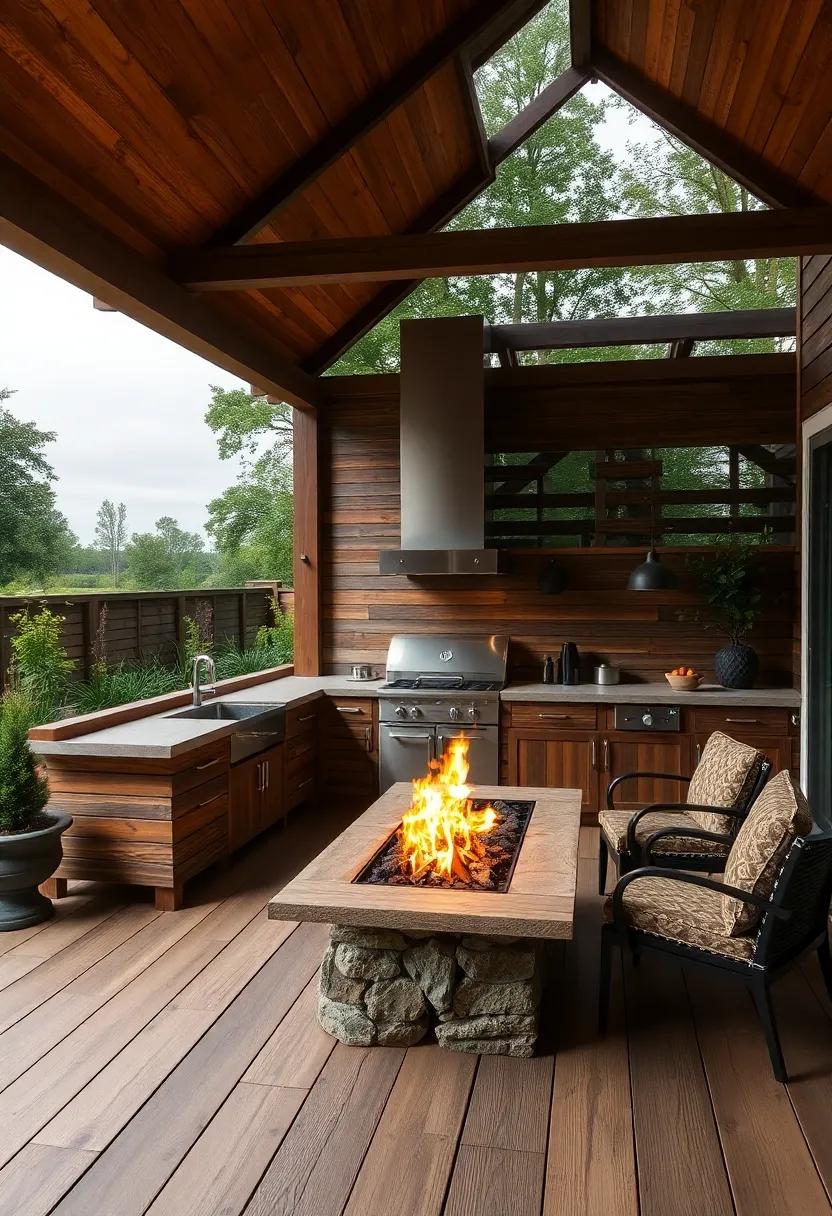
Fire pits have become a quintessential element of outdoor kitchens, infusing warmth and ambiance that transform mundane evenings into enchanting gatherings. As you blend the aesthetics of wood craftsmanship with the natural allure of flames, the result is a culinary sanctuary where aromas of grilled offerings dance in harmony with crackling embers. The incorporation of a fire pit not only enhances functionality but also creates a striking focal point, offering a seamless transition between cooking and lounging areas, encouraging a social atmosphere around the warmth of fire.
When integrating a fire pit into your outdoor design, consider the materials that will harmonize with your existing space. Here are a few options to inspire your selection:
- Brick and Stone: Timeless and durable,perfect for rustic settings.
- steel and Aluminum: Modern and sleek, ideal for contemporary environments.
- Wood-Enclosed Pits: Natural and inviting, they create a cozy vibe.
To further enhance your outdoor culinary experience, pairing your fire pit with specialized seating arrangements can elevate gatherings.A well-planned layout encourages interaction, making cooking and dining a communal affair. below is a simple chart to help you visualize seating arrangements that work harmoniously with fire pits:
| Seating Type | Best For |
|---|---|
| Adirondack Chairs | Relaxed gatherings |
| Bar Stools | Casual dining |
| Outdoor Sofas | Cozy lounging |
Imagining Culinary Retreats with Organic Shapes and Wooden Structures
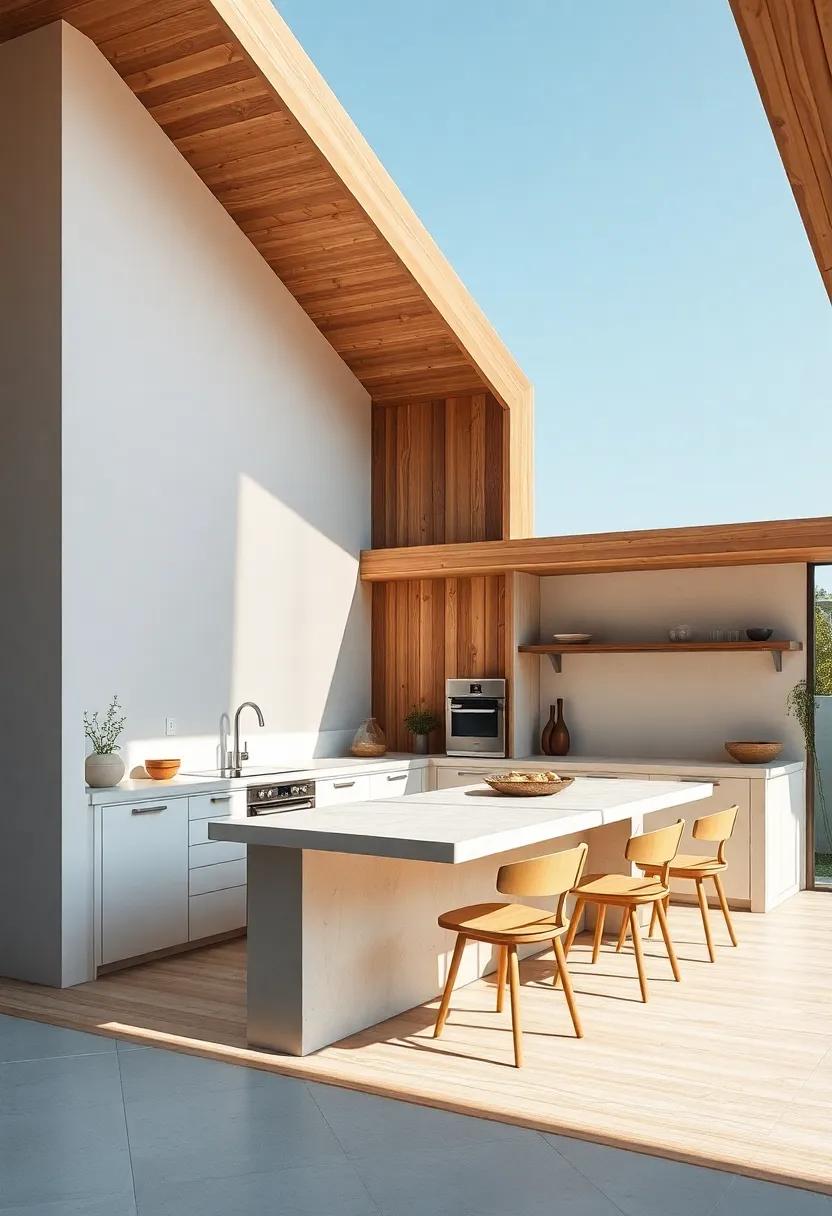
Envision an outdoor kitchen nestled within a serene landscape,where culinary artistry meets the raw,organic beauty of nature. Here,curvilinear forms blend harmoniously with wooden structures,creating spaces that inspire creativity and connection. The gentle curves mimic the shapes found in nature, from the flowing lines of a river to the organic silhouette of a leaf, allowing chefs to feel a profound connection with their surroundings. Choose materials sustainably sourced, like reclaimed wood, ensuring that each eave and beam not only serves a functional purpose but tells a story of craftsmanship and respect for the environment.
This retreat becomes a playground for the senses, inviting elements such as natural light and fresh air to enhance the cooking experience. Consider incorporating features like:
- Organic garden beds: Perfect for planting herbs and vegetables right at your fingertips.
- Outdoor seating areas: Crafted from timber, fostering a communal atmosphere.
- Open-fire pits: For grilling and roasting, echoing age-old culinary traditions.
To complement the aesthetic, furniture and fixtures crafted from wood should be thoughtfully designed, promoting both comfort and functionality. The rhythm of different textures—from rough-hewn tables to smooth counter surfaces—creates visual interest and warmth, making the space not just a kitchen, but a gathering place where memories are made.
Integrating Natural Light and Wood for Inviting outdoor Cooking Areas
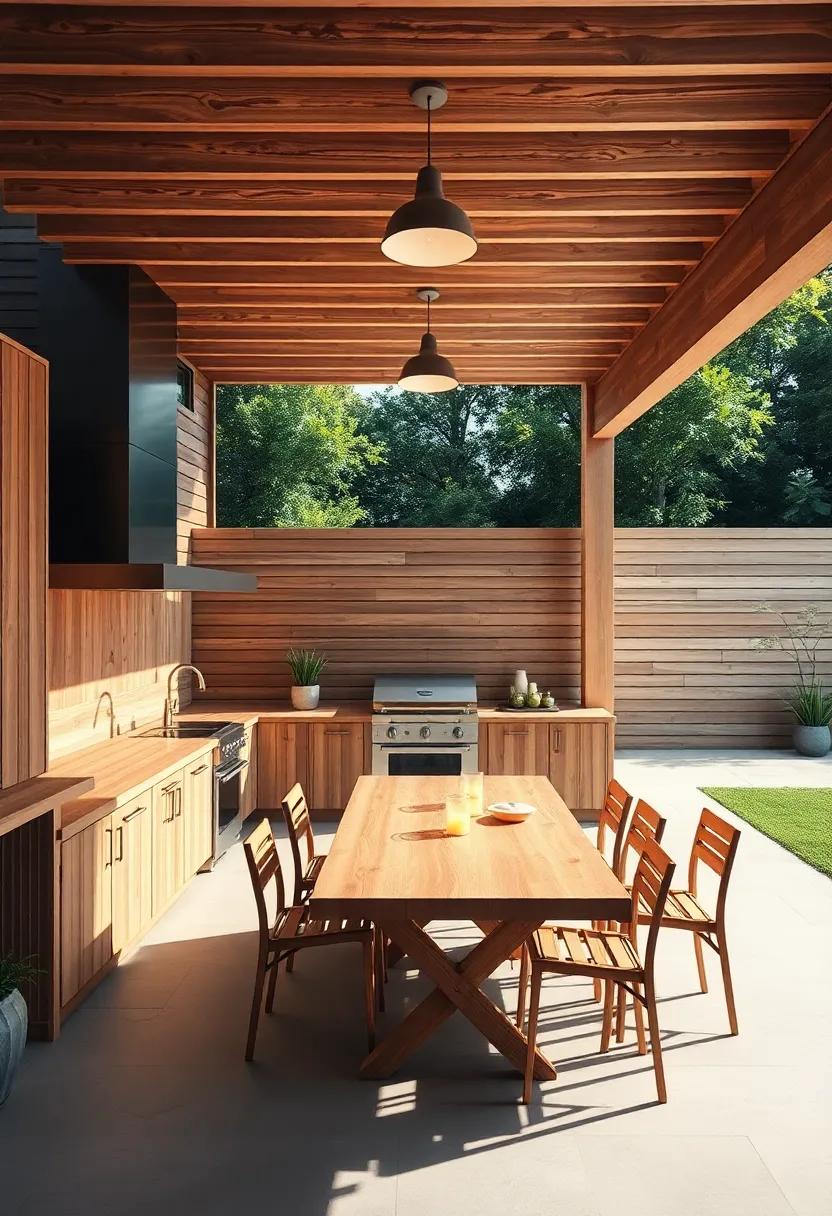
embracing the beauty of natural light in outdoor cooking areas can transform the ambiance, making it a delightful space for culinary exploration. Large windows, strategically placed skylights, and open layouts invite sunlight to cascade into the environment, creating an inviting and luminous atmosphere. With wooden beams and accents, the design fosters a warm, rustic charm that complements the natural light perfectly. imagine hosting a gathering beneath a gracefully arched wooden pergola, where sunlight dances through the leaves and highlights the natural grains of the wood, heightening the connection between the indoors and outdoors.
To enhance both functionality and aesthetic appeal, consider integrating elements such as wooden countertops and pergolas that create shaded areas while allowing light to filter through. Utilize materials that harmonize with the outdoor setting, such as reclaimed wood or cedar, to add texture and warmth. Key features to incorporate into this design include:
- Outdoor Islands – Perfect for meal prep while enjoying the sun.
- Built-in Seating - Incorporates wood gracefully, inviting guests to linger.
- Fire Features – Enhances warmth and light during evening gatherings.
The interplay of natural light and the earthy tones of wood not only creates a stunning visual narrative but also imbues the space with a sense of peace and contentment. It encourages culinary creativity, allowing you to savor every moment spent in this outdoor oasis.
Culinary Retreats that inspire: The transformative Power of wood
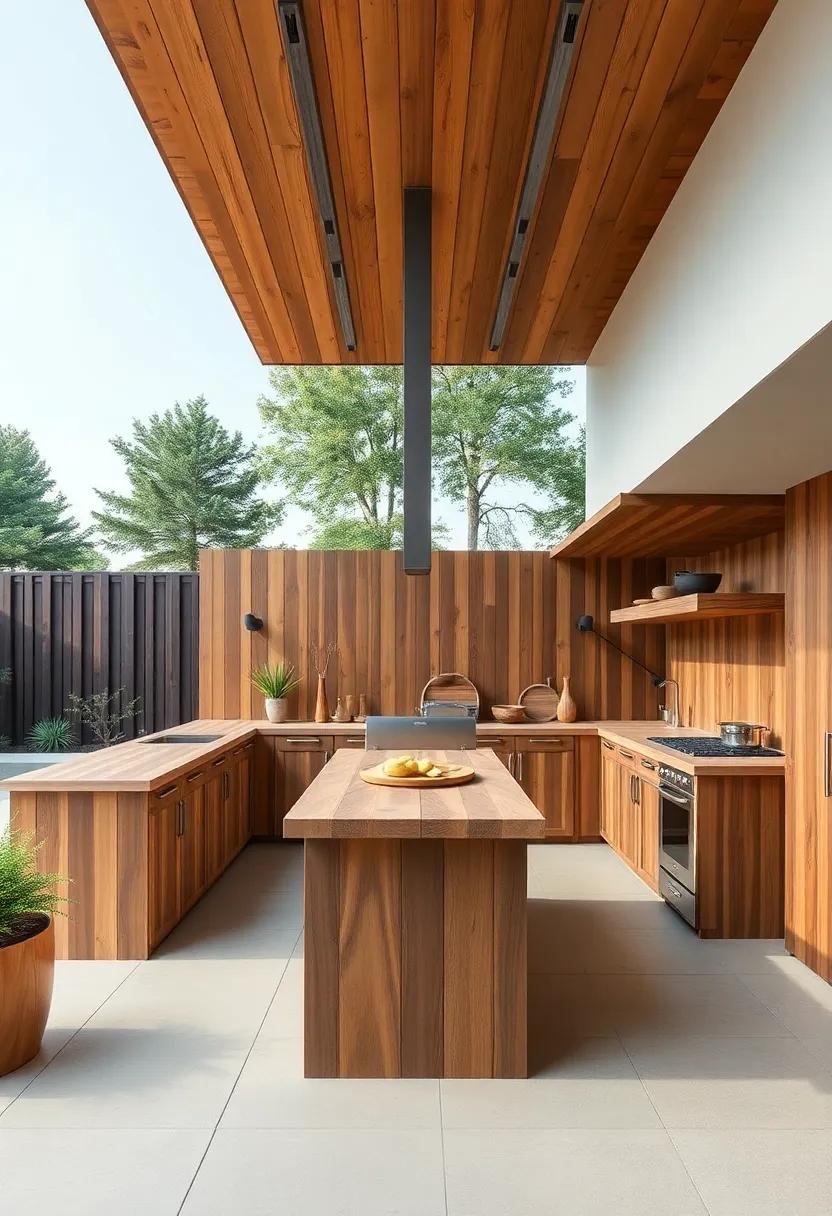
Wood, as a primary element in outdoor kitchen design, not only enhances the aesthetic appeal of a culinary retreat but also fosters a unique sensory experience that connects participants with nature. When guests gather around a wooden island or grill, they feel the warmth and texture of the material, creating a welcoming atmosphere that invites creativity and interaction. The rich, varied hues of wood—ranging from deep mahogany to light maple—can evoke different emotions and inspirations, making the cooking experience more profound and enjoyable.This natural centerpiece serves as a backdrop for culinary exploration, bridging the gap between the chef and the guest, and turning every meal into a celebratory occasion.
Incorporating wood into outdoor kitchens can enhance functionality while deepening the recognition for culinary artistry.The following elements can be beautifully crafted from wood to elevate the retreat experience:
- Cutting Boards: Handcrafted pieces that become cherished tools in culinary creations.
- Cabinetry: Custom wood cabinets provide ample storage and showcase a rustic touch.
- Dining Tables: Large communal tables made from reclaimed lumber foster shared meals and conversations.
- Cooking Stations: dedicated areas designed for preparing and cooking that blend seamlessly with the landscape.
As retreats embrace the allure of wood, the integration of this natural material allows hosts and guests alike to savor the tactile and visual elements of their environment. This connection to nature not only transforms flavors but also enriches the overall experience of cooking and dining outdoors, making each gathering a journey of both taste and mindfulness.
Designing Rustic Charm: The Timeless Appeal of classic Wooden Kitchens
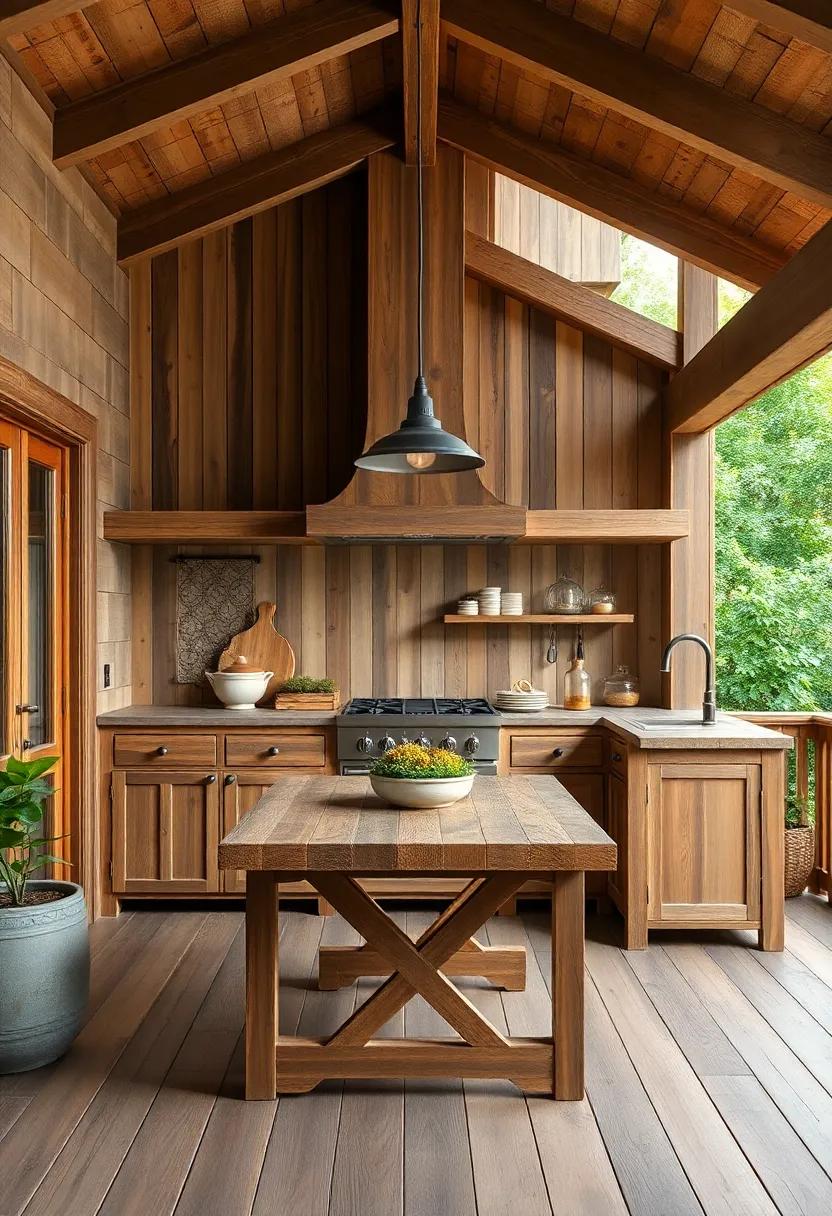
The allure of classic wooden kitchens lies in their ability to evoke a sense of warmth and comfort, making them ideal for both culinary creations and casual gatherings. Rich textures and natural finishes create an inviting environment where family and friends can connect over delicious meals. Consider incorporating various types of wood, such as cedar, oak, or teak, which not only provide durability but also contribute a unique character to your outdoor kitchen space. Some popular design elements for achieving rustic charm include:
- Reclaimed wood Accents: Utilizing salvaged timber adds a past depth and eco-amiable appeal.
- Open Shelving: Showcasing wooden shelves can enhance accessibility while allowing for decorative displays.
- Natural Stone Countertops: Combining wood with stone introduces tactile contrast that highlights the beauty of both materials.
- Crafted Furniture: Invest in custom wooden tables and stools that provide both functionality and aesthetic value.
Furthermore, the versatility of wood can be showcased through thoughtful details that enhance the overall aesthetic.Consider using a combination of traditional joinery techniques and modern finishes to create eye-catching focal points such as oversized islands or rustic bar areas. Understated elements like wooden beams, butcher block surfaces, and farm-style sinks can seamlessly blend contemporary functionality with classic charm.Below is a table highlighting some essential wooden kitchen features that contribute to rustic allure:
| feature | Description |
|---|---|
| Wooden cabinets | Sturdy and stylish; ideal for a rustic finish. |
| Natural Finish | Retains the grain pattern and uniqueness of wood. |
| Composite Materials | Combines recycled wood for an eco-friendly touch. |
| Antique Fixtures | Complements wooden elements with a nostalgic twist. |
Creating a Unique Culinary Identity with handcrafted Wooden Details
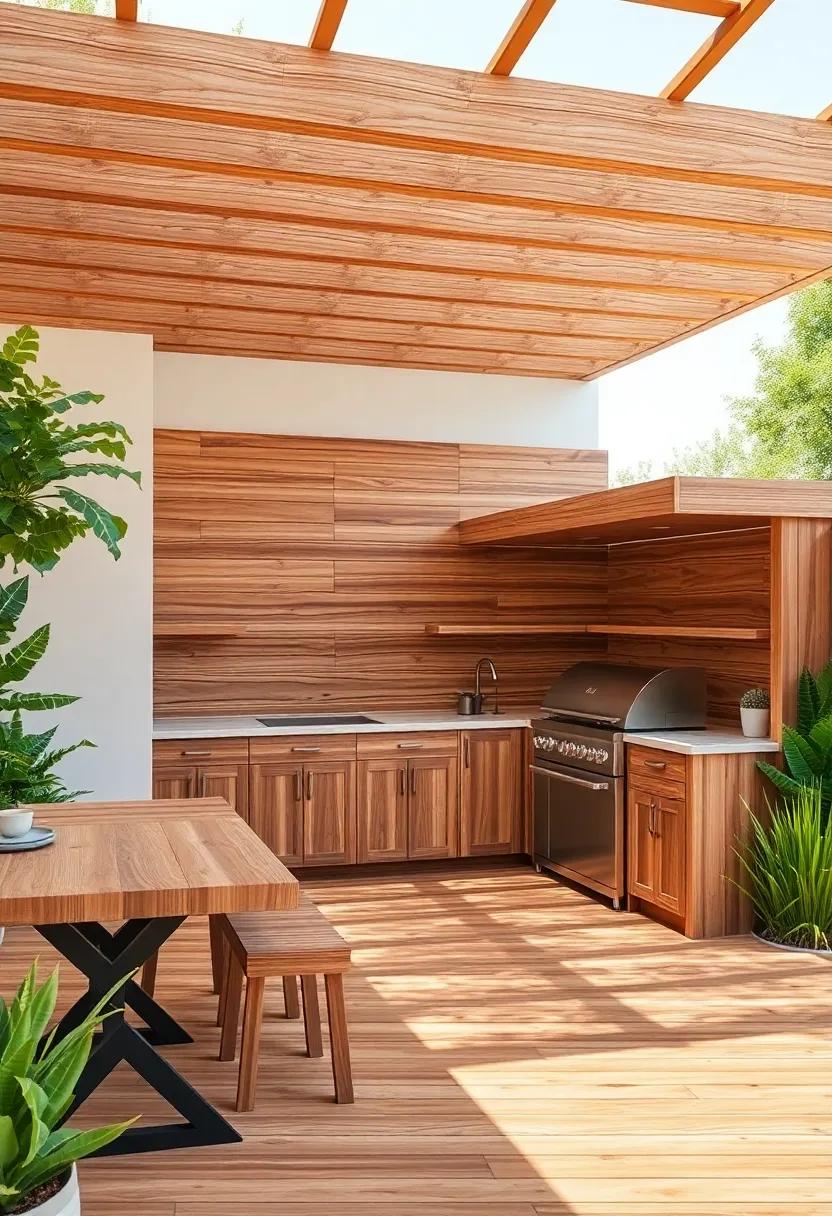
Embracing the natural beauty of handcrafted wooden details can transform outdoor kitchens into enchanting culinary retreats. The warmth and texture of wood introduce a sensory experience that draws people in, inviting them to savor not just food but the atmosphere itself. Custom wooden countertops, with their unique grains and finishes, provide a perfect canvas for food preparation while radiating charm and elegance. Complementing this, wooden shelving and cabinetry offer practical storage solutions, showcasing spices and ingredients while adding to the rustic aesthetic of the space.
Moreover, incorporating accent pieces like wooden serving boards, utensils, and decorative elements can enhance the cohesive theme of the outdoor kitchen. Utilizing responsibly sourced timber not only elevates the design but also aligns with sustainable practices,creating a culinary oasis that reflects a commitment to the earth.below is a simple overview of essential wooden elements to consider for your outdoor kitchen:
| Wood Element | Function | Aesthetic Appeal |
|---|---|---|
| countertops | Food prep surface | Warmth & texture |
| Shelving | Storage & display | Rustic charm |
| Serving Boards | Food presentation | Natural beauty |
| Utensils | Cooking & serving | Organic touch |
Wrapping Up
As we conclude our exploration of the enchanting world of outdoor kitchens, it’s clear that wood is not just a material; it’s a bridge between nature and culinary creativity. These retreats, crafted with care and intention, invite us to step outside the confines of our conventional dining spaces and immerse ourselves in the symphony of flavors, aromas, and sounds that the outdoors has to offer. The warmth of wood, whether in sleek countertops, rustic cabinets, or elegant beams, transforms these kitchens into havens of inspiration and connection.
As you envision your own culinary retreat, consider the potential that lies within wood’s natural beauty and versatility. Every grain tells a story, waiting to be woven into the fabric of your outdoor dining experiences. So gather your ingredients, ignite your passion for cooking, and let the allure of wood guide you to create a space where memories are made, flavors are celebrated, and the great outdoors becomes an integral part of your culinary journey. it’s not just about cooking; it’s about crafting an experience that nourishes both body and soul in the heart of nature. Happy cooking!
As an Amazon Associate I earn from qualifying purchases.
